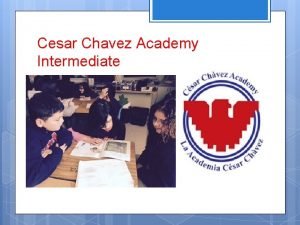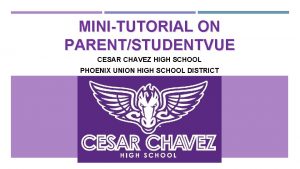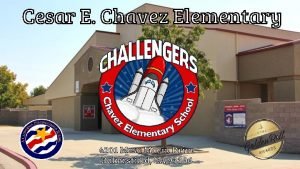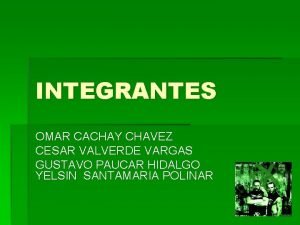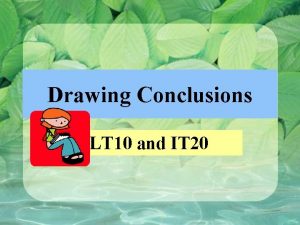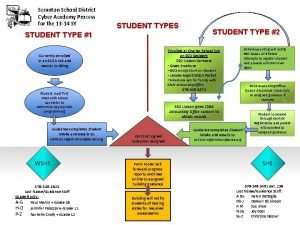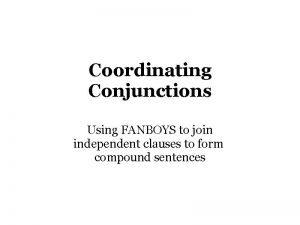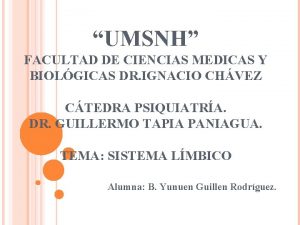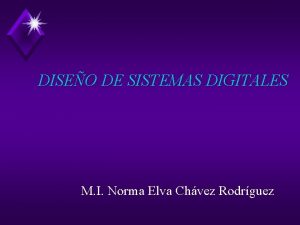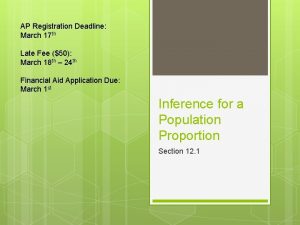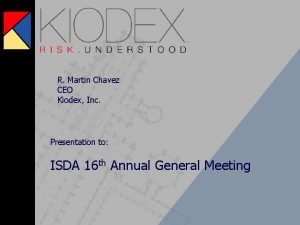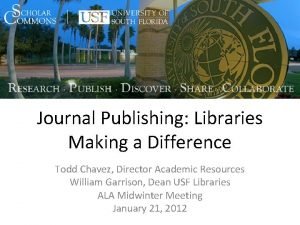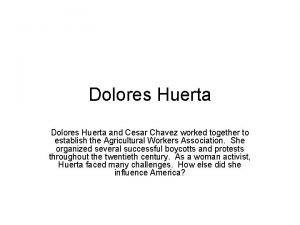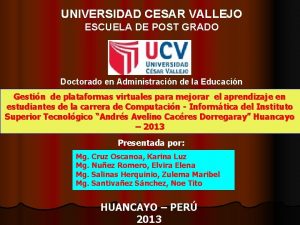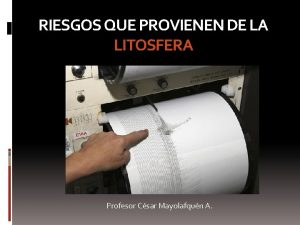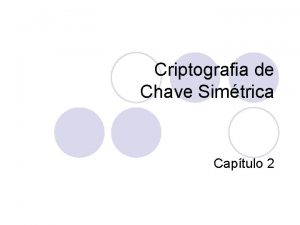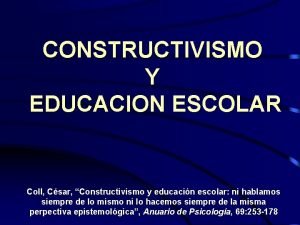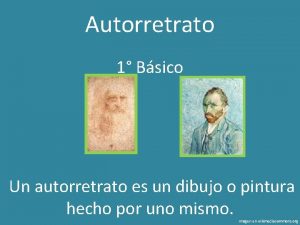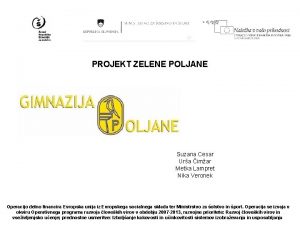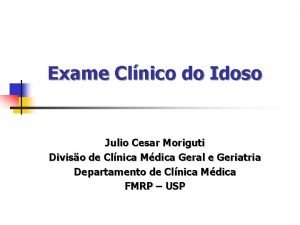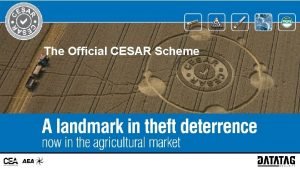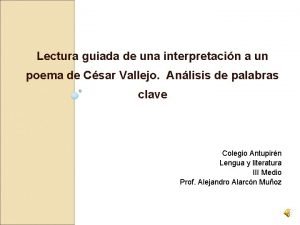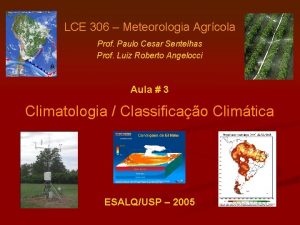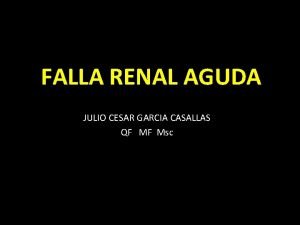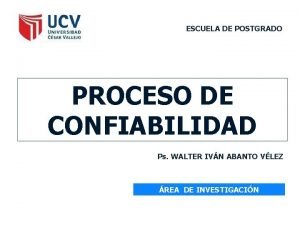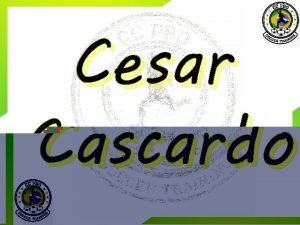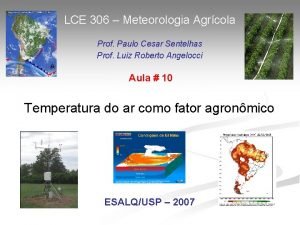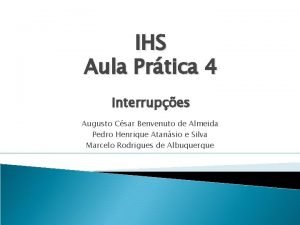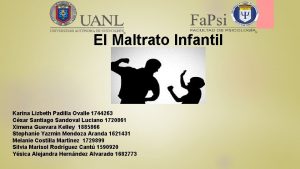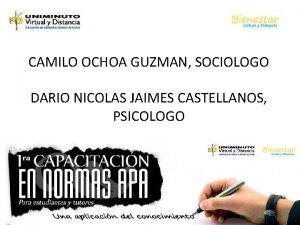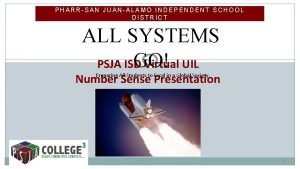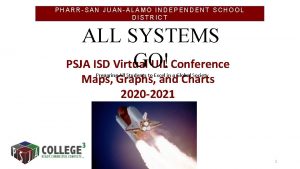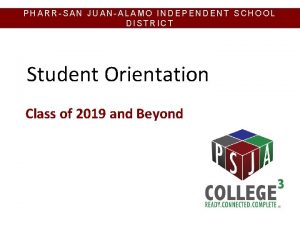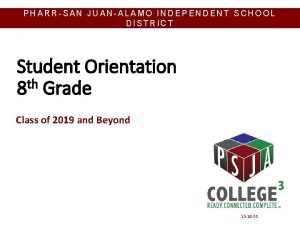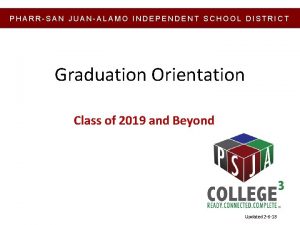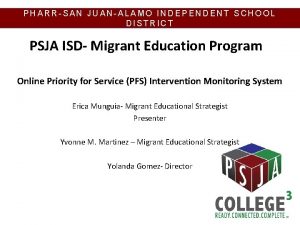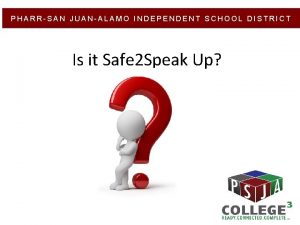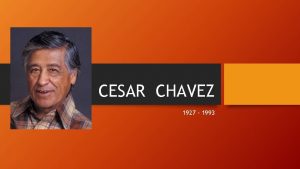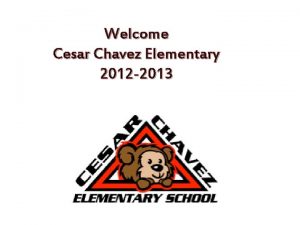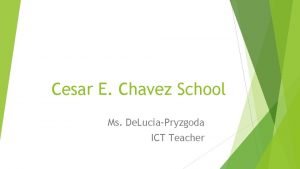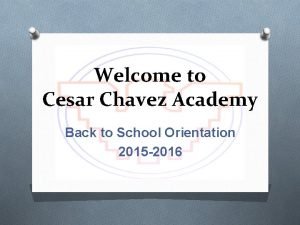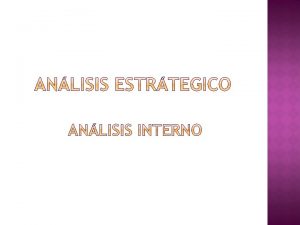PHARRSAN JUANALAMO INDEPENDENT SCHOOL DISTRICT Cesar Chavez Elementary
























































- Slides: 56

PHARR-SAN JUAN-ALAMO INDEPENDENT SCHOOL DISTRICT Cesar Chavez Elementary School Campus Improvement Plan 2020 -2021 Board Approved: 1

Executive Summary Campus Improvement Plan: School Year 2019 -2020 Campus Name: Cesar Chavez Elementary Mission: It is the mission of the staff of Cesar Chavez Elementary (CCE) to provide student with the necessary knowledge and skills to prepare them to be academically and socially college and career ready. Demographics Summary: Cesar Chavez Elementary (CCE) is located 7 miles north of the Mexican border. As a suburban Title 1 school with a large Hispanic population, CCE students and families face many economic challenges. Many in the community are economically disadvantaged, live below the poverty line, and reside in subsidized housing. With a familial atmosphere, it is the goal of CCE to make the students feel safe and protected. CCE houses both general education and a self-contained special education classroom. The campus serves 475 students ranging from PK to 5 th grade. Of these students, 76% have been identified Limited English Proficient, 95% have been identified as economically disadvantaged and qualify for free or reduced lunch. Also, 94% of the students have been identified at risk of not graduating from high school. The student population consist of 99% Hispanic and 1% reporting other ethnic background. Comprehensive Needs Assessment Summary: Cesar Chavez received an overall grade of 94 out of 100 based on performance in three different areas, or domains. In the student achievement domain, Chavez earned 91% which shows how much students know and can do at the end of the school year. The school in Progress, earned 89% which shows how students perform over time and how that growth compares to similar schools. Chavez scored 100% in Closing Gaps, the domain which shows how well different groups within a school are performing. Curriculum/ Instruction and Assessment: Cesar Chavez Elementary is a Dual Language Campus. Students are provided content area instruction in English and Spanish by highly qualified and certified bilingual teachers. The goal of the program is for the students to become bilingual, bicultural, and to be able to achieve a high degree of bi-literacy and academic achievement in both languages. Cesar Chavez Elementary strives for success in all areas. Students are followed through their school careers and showcased in the front of school as Chavez alumni. The expectations are high, but the reward is great. CCE endeavors to produce 21 st century leaders who will carry their community into the future. Chavez Elementary believes in achieving success through innovation and excellence. To ensure that students are mastering the TEKS, teachers continuously reflect upon their instructional methods and interventions by collaboratively interpreting assessments data during their weekly CLC (Collaborative Learning Communities) meetings. This approach has impacted their ability to close achievement gaps, which is evident in the growth of their students. Summary of Goals: The Texas Essential Knowledge and Skills (TEKS) Provide the foundation for the core curriculum at CCE. Teachers also implement with fidelity a common instructional framework (CIF) throughout the core curriculum areas. CIF is composed of six common instructional strategies: collaborative group work, writing to learn, scaffolding, questioning, classroom talk, and literacy groups. These strategies drive instructional practices at CCE and have led to its success in closing the achievement gaps. CCE implements the districts’ Two-Way Dual Language Enrichment Program (DLAP) in a way that empowers students to become biliterate in English and Spanish. This means English language learners and Spanish language learners work side by side to help each other with the acquisition of social and academic language. Promoting the bilingual/bicultural competencies aligned with the TEKS in English and Spanish through a 50/50 instructional model, enhances the student’s proficiency in both languages. All staff helps with this endeavor by implementing the language of the day and by encouraging the students to do the same in all setting throughout the school. The practice of DLEP prepares students with the necessary skills to become bilingual, biliterate and bicultural members of society. Overall, CCE believes that academic success and closing the achievement gap would not be possible without first providing an environment that makes students feel safe and secure. This practice of promoting a nurturing environment has proven successful year after year. Roel Faz Erica Estrada Principal Cesar Chavez Teacher Carolina Delos Santos Parent 2

PHARR-SAN JUAN-ALAMO INDEPENDENT SCHOOL DISTRICT Mission Statement As educational leaders, the PSJA team is engaged and empowered to connect all students with innovative instruction, outstanding facilities, technology, skills, and social-emotional support while prioritizing health and safety for all-from early childhood through their chosen career. As one PSJA family, we build on our legacy of academic excellence, renowned college and career readiness, biliteracy and extracurricular programs, and our multicultural heritage to ensure every student has the experiences and resources necessary to achieve the highest levels of success. 3

Cesar Chavez Elementary School 2018 Blue Ribbon School Vision: Cesar Chavez Elementary will provide an education that will develop successful learning Cesar Chavez Elementary will provide innovative quality instructional strategies and leadership. Cesar Chavez Elementary will use character education to teach students to be responsible and develop good moral values Cesar Chavez Elementary staff, parents and community will work united to develop a safe school environment that is conducive to student success. Mission Students at Cesar E. Chavez Elementary will become excellent readers, problem solvers, critical thinkers, self-motivated, and be well disciplined. This will be achieved by working collaboratively, setting high expectations and by providing a student-centered environment 4

Cesar Chavez Elementary SCHOOL PROFILE Cesar Chavez Elementary (CCE) is located 7 miles north of the Mexican border. The school was established in 1999 as the only school in the rural community of " Las Milpas. " Translated from Spanish, "Las Milpas" means the cornfields. CCE opened its doors in 1999 to serve students from the local migrant community. The school was appropriately named to honor the Mexican-American labor leader Cesar E. Chavez who used non-violent methods to fight for the rights of migrant farm workers in the United States. The campus serves 475 students ranging from PK- 5 th grade. Of these students, 76. 70% have been identified Limited English Proficient, 100% have been identified as economically disadvantaged and qualify for free or reduced lunch. Also, 94. 4% of the students have identified at risk of not graduating from high school. The student population consist of 99% Hispanic and 1% reporting other ethnic background. Cesar Chavez Elementary strives for success in all areas. Students are followed through their school careers and showcased in the front of the school as Chavez alumni. The expectations are high, but the reward is great. CCE endeavors to produce 21 st century leaders who will carry their community into the future. 5

Campus SBDM Committee Staff Member Role Carolina Delos Santos Parent Business/ Community Partner Roel Faz Principal Sandra Gutierrez Miranda Assistant Principal Veronica Garza Counselor Ruby Lopez CLL Erica Estrada Lead Teacher Olga Aldana Lead Teacher Norma Garza Lead Teacher Andrea Gonzalez Lead Teacher Monica Valls Lead Teacher Lesley Robles Montoya Lead Teacher Hortencia Enriquez Lead Teacher 6

Site-Based Decision-Making Committee SBDM will address the following areas: • Planning • Budgeting • Curriculum • Staffing patterns • Staff development • School organization 7

Site-Based Decision-Making Committee Operating Procedures: The SBDM serves as the key committee in the Campus Intervention Team to assist the campus principal with the development, review, and revision of the CIP. All SBDM information must be included on the campus website. The organizational structure of the school’s SBDM including subcommittees, membership, and operating procedures of the subcommittees and should include the meeting schedule for both the SBDM and subcommittees. The SBDM shall be involved in decisions in the areas of planning, budgeting, curriculum, staffing patterns, staff development, and school organization. A list of meeting dates, committee members, agendas and minutes for each meeting must be on the campus website. The campus website homepage must include the link to the SBDM page for easy access. Campuses must post SBDM agenda and minutes to campus website within 10 days following meeting. Scheduled Meeting Dates: September 1, 2020, November 19, 2020, January 21, 2021, May 28, 2021 Committee Roles and Responsibilities: Chair – prepares committee meeting agendas with the assistance of the principal, guide meetings and encourage input from all members Vice-Chair – performs Chair’s duties in his/her absence; serves as chair of the Evaluation and Modification Committee Scribe/Recorder – prepare and maintain minutes of committee meetings, committee membership roster and bylaws Facilitator/Timekeeper – monitors committees' energy and interaction, keeps committee on track and ensures activities are completed in a timely manner 8

Site-Based Decision-Making Committee Procedures and processes for addressing SBDM action items and decision making: 1. Announcement of SBDM meeting announced to staff 2 weeks before meeting. 2. Committee representative submits request to SBDM chairperson. 3. One week before meeting SBDM meeting, chairperson meets with campus administration to discuss topics. 4. Selection of topics to be covered will be determined by administration and SBDM chairperson. 5. If a topic is not going to be addressed, SBDM chairperson and administration will provide further information for not taking the topic to SBDM. Topic may be resolved via conference with teacher and/or grade level team. An outline of the method of submitting items for the agenda which indicates whether submission procedures are the same or different for school personnel, parents, and community representatives. This section should describe the method of communicating SBDM decisions to non-SBDM members, including other school staff members, parents, and community members. 9

Comprehensive Needs Assessment Data Resources Reviewed 1. 2018 -19 STAAR Campus Summary Report 2. 2018 -19 Attendance 3. Discipline Referrals 4. PEIMS Demographics 5. Walk-through Data 6. Parental Involvement Data 7. Mc. REL Teacher Evaluations 8. Professional Development Plan 9. Teacher Certifications 10. TELPAS Scores (2019 -2020) 11. Technology Inventories (purchases made) 12. Benchmark 2 (Spring 2020) 13. LEP progress monitoring 14. Special population participation and performance 15. Campus report card 10

Comprehensive Needs Assessment Demographics Summary Special Education: The following accountability sources were used to review the Special Education data by the Campus Site-Based Decision-Making Committee (SBDM): State of Texas Assessments of Academic Readiness (STAAR) results, Performance Based Monitoring Assessment System (PBMAS) and State Performance Plan (SPP) indicators to determine strengths and needs of our Special Education students. In addition, the Special Education Department was very involved in the curriculum writing and revision for grades K-5 during the summer to ensure that the general curriculum meets the needs of our special education students. Professional development is also coordinated with the curriculum and instruction department to ensure that all general education teachers are well versed in best practices that support the learning of special education students. Needs: Align student goals and objectives outlined in IEP with TEKS being assessed on STAAR, STAAR Online and STAAR-Alt 2. Personnel Needs: Campus Administrators will work closely with Human Resources (HR) to ensure the selection of highly qualified employee(s) holding valid state issued certification. Professional Development Needs: Special Education Staff will be included in all Professional Development (PD) provided by the campus/district in the areas that are to be addressed by individual students. The Special Education Department will work closely with the Campus and provide PD in the area of co-teaching to implement the inclusion model effectively. 11

Comprehensive Needs Assessment Demographics Summary Continued: English Learners (EL): The following accountability sources were used to review the Bilingual Education/Dual Language (BE/DL) Department data by the SBDM Committee: State of Texas Assessments of Academic Readiness (STAAR) results, Performance Based Monitoring Assessment System (PBMAS) and TELPAS indicators to determine strengths and needs of our EL students. The BE/DL Department was very involved in the curriculum writing and revision for grades K-5 during the summer to address the needs of our EL students and align the curriculum between English and Spanish Language Arts that led to a more coherent and consistent bi-literacy program. Professional development was also coordinated with the curriculum and instruction department to ensure that all general education teachers utilize best practices that support the learning of EL students. Needs: As evidenced in the STAAR assessments , the results are as follow: Reading 90% Math 93% Writing 87% Science 91% • In Reading, the achievement gap between EL and All students 2017 -2018 to 2018 -2019 is 0%. • In Math, the achievement gap between EL and All students 2017 -2018 to 2018 -2019 is -1%. • In Writing, the achievement gap between EL and All students 2017 -2018 to 2018 -2019 is -1%. • In Science, the achievement gap between EL and All students 2017 -2018 to 2018 -2019 is -2%. 12

Comprehensive Needs Assessment Demographics Summary Continued: Economically Disadvantaged The following accountability sources were used to review the Economically Disadvantaged data by the SBDM: State of Texas Assessments of Academic Readiness (STAAR) results, and System Safeguards to determine strengths and needs of our Economically Disadvantaged Students. Needs: As evidenced in the STAAR assessments , the results show an achievement gap as follows: Reading 90% Math 93% Writing 87% Science 94% • In Reading, the achievement gap between Eco Dis and All students 2017 -2018 to 2018 -2019 is 0%. • In Writing, the achievement gap between Eco Dis and All students 2017 -2018 to 2018 -2019 is -1%. • In Science, the achievement gap between Eco Dis and All students 2017 -2018 is to 2018 -2019 -1%. 13

Comprehensive Needs Assessment Continued: Goal 1 -8 Summary of Findings DOMA IN 1 Area Reviewed Domain 1: Student Achievement Summary of Strengths 2018 All Subjects Approaches: 87% Meets: 57% Masters: 26% Summary of Needs Root Cause Priorities • 2018 Campus overall Domain 1 Score 87%, 2019 Campus overall Domain 1 score 90%. With Covid -19, and the way it affected the educational system worldwide…steps will need to take place in order to form a normal learning environment for students and teachers. Being away from the classroom for almost 8 months will bring a catastrophic situation to the educational system if nothing is addressed during this historic pandemic event. Improve student learning outcomes in : • 4 th Grade Reading and Math • 3 rd Grade Reading/Math • 5 th Grade Science/Reading • 4 th Grade Writing 2019 All Subjects Approaches: 91% Meets: 60% Masters: 31% 2 Domain 2: Student Progress Part A Student Progress Part B Domain 2 Part B performance was higher than Part A. 2019 Part A: 89 Part B: 92 2018 Part A: 90 Part B: 91 • Address the needs of all students in each student group. • Identify the student's previous performance and set specific goals by individual's students. • Goal for Part A is 90 or above • Goal for Part B is 90 or above. • Teachers will continue to monitor students. . virtually or face to face • Steps will be made to address the SEL of students (Social Emotional Learning) • Address the needs of identified students to meet the progress measure in 202021 in Reading and Mathematics. 3 Domain 3: Closing the Achievement Gap Campus had 100% of students’ gap closed. • Goal is to perform at 100. Focus is to have SPED population perform at MEETS or above. Continue to work on TELPAS component: Monitor the rest of groups English Language Proficiency Status 2019: Target 36% Progress rate 40% Special population groups SPED EL’s Cesar Chavez received 6 distinction designations in 1. Reading/ELA 2. Math 3. Science 4. Top 25% Academic Growth 5. Top 25% Closing Gaps 6. Post Secondary readiness Cesar Chavez Elementary MET STANDARD. Final campus score was 94%. Goal is to have a 95% or higher for Spring 2021. Goal for 2021 is to maintain all 6 distinctions in core content areas. Students will continue to work on intervention programs. 1. Voyager 2. Herman Method 3. Istation/ Imagine Math 4. Fluency 5. Tutoring Improvement in 20182019 RDG 86%-----90% WTG 76%-----87% Math 90%-----93% Science 94%----94% Campus Total Cesar Chavez Elementary went from an overall score of 86 to 90 in one school year. 14

Summary of Findings GOAL Area Reviewed Summary of Strengths Summary of Needs Problem & Root Cause Priorities 5 Family and Community Involvement • Neighborhood outreach/ARISE • Communication in both English and Spanish • Parental involvement • Parent Center • Business Partnerships • Parent Advisory Committee (PAC) • Increase parent involvement • Increase number of parents participating in the special programs offered by PSJA ISD • Increase volunteer hours • Lack of parental participation/involvement in school. • Low average of parents with high school diplomas and /or postsecondary education • Create opportunities for parents to receive postsecondary training/education (Valley Interfaith) (ARISE) • Initiate parent academic conferences through DE Program 6 Technology • Availability of technology resources for students and teachers • CIT training is readily available • • Need access to ipads for school Purchase covers for ipads Printer ink is limited Further mimio training to create presentations • Need student device for 1 -1 • Integration of technology in instruction and increase the use of student technology for instructional rigor • CIT/ Librarian will provide training on the implementation of technology integration ; increase on-line resources 7 School Culture and Climate • • Respect Skills Student attendance Customer Service Collaborative Learning Communities (CLC’s) • Extra planning periods to finish RTI’s/504 • Consistency of essential agreements across campus. • Implement a campus – wide consistency committee to address solutions to everyday scenarios • Communicate with community Covid – 19 concerns • Provide a safe learning environment for students 8 Staff Quality, Recruitment, and Retention • • • Highly Qualified Staff New Teacher Academy Mc. REL Evaluation Tool Mentorship CLL, Grade Level Chair and Admin • New teachers are overwhelmed with district initiatives • Not enough time throughout the day to finish everything…. • New teachers lack basic understanding of the instructional process and TEKS- Curriculum. Assessment Alignment • Schedule time for new teachers to observe and work with experienced teachers on a weekly basis 15

CAMPUS DEMOGRAPHICS ALL SPED LEP MIGRANT ECD GT Number 475 42 198 9 178 8 Percent 100 5. 1 76 . 8 70 . 6 ALL HISPANIC ASIAN BLACK WHITE AMERICAN INDIAN/ALASKAN Number 475 0 0 Percent 100 0 0

2020 -2021 District Goals 3 rd Grade Reading % of Students Passing State Assessment Goal 2019 2021 Approaches 88% 89% 55% Meets 56% 30% Masters 35% % of Students Passing State Assessment Goal 2019 2021 Approaches 88% 89% Meets 50% Masters 28% % of Items Needed to Meet State Performance Standard 5 th Grade Reading 4 th Grade Reading % of Items Needed to Meet State Performance Standard % of Students Passing State Assessment Goal 2019 2021 Approaches 96% 97% 60% Meets 52% 55% 38% Masters 19% 35% % of Items Needed to Meet State Performance Standard

2020 -2021 Campus Goals 3 rd Grade Mathematics % of Students Passing State Assessment Goal 4 th Grade Mathematics % of Students Passing State Assessment Goal 2019 2021 % of Items Needed to Meet State Performance 4 th Grade Mathematics District Standard 2019 2021 Approaches 88% 89% Approaches 88% 90% Meets 41% 45% Meets 61% Masters 19% 25% Masters 25% % of Items Needed to Meet State Performanc e Standard 5 th Grade Mathematics % of Items Needed to Meet State Performance Standard % of Students Passing State Assessment Goal 2019 2021 Approaches 100% 65% Meets 83% 85% 30% Masters 52% 57%

2020 -2021 District Goals 4 th Grade Writing % of Students Passing State Assessment Goal % of Items Needed to Meet State Performance Standard 2019 2021 Approaches 87% 88% Meets 59% 60% Masters 33% 38%

2020 -2021 District Goals 5 th Grade Science % of Students Passing State Assessment Goal % of Items Needed to Meet State Performance Standard 2019 2021 Approaches 94% 96% Meets 78% 80% Masters 38% 40%

THE BOARD OF EDUCATION GOALS AND PROGRESS MEASURE Goal 1: The percent of students in grade 3 who perform at meets grade level or above on STAAR Reading will increase from 46% to 55% by June 2023. Goal Progress Measure 1. 1: The percent of grade 3 students who reach above the 60 th percentile by End of Year Assessment will increase from 25% to 34% by 2023. Goal Progress Measure 1. 2: The percent of grade 2 students who reach above the 60 th percentile by End of Year Assessment will increase 25% to 34% by 2023. Goal Progress Measure 1. 3: The percent of grade 1 students who reach above the 60 th percentile by End of Year Assessment will increase from 23% to 32% by 2023. Goal Progress Measure 1. 4: The percent of grade kindergarten students who reach above the 60 th percentile by End of Year Assessment will increase 15% to 23% by 2023. Goal 2: The percent of students in grade 3 who perform at meets grade level or above on STAAR Mathematics will increase from 56% to 65% by June 2023. Goal Progress Measure 2. 1: Proficiency in grade 3 students on Imagine Math Beginning of Year Assessment will increase from 7% to 16% by 2023. Goal Progress Measure 2. 2: Proficiency in grade 2 students on Imagine Math Beginning of Year Assessment will increase from 33% to 42% by 2023. Goal Progress Measure 2. 3: Proficiency in grade 1 students on Imagine Math Beginning of the Year Assessment will increase from 11% to 19% by 2023. Goal Progress Measure 2. 4: Proficiency in grade kindergarten on Imagine Math Beginning of the Year Assessment will increase from 1% to 10% by 2023. Goal 3: The percent of students in grades 5 -8 who perform at meets grade level or above on STAAR Reading will increase from 45% to 55% by June 2023. Goal Progress Measure 3. 1: The percent of students in grade 5 at meets level on STAAR Reading will increase from 53% to 60% by June 2023. Goal Progress Measure 3. 2: The percentage of students in grade 6 at meets level on STAAR Reading will increase from 26% to 30% by June 2023. Goal Progress Measure 3. 3: The percent of students in grade 7 at meets level on STAAR Reading will increase from 37% to 42% by June 2023. Goal Progress Measure 3. 4: The percent of students in grade 8 at meets level on STAAR Reading will increase from 42% to 47% by June 2023. Goal 4: The percent of graduates who are College, Career and Military Ready will increase from 70% to 80% by June 2023. Goal Progress Measure 4. 1: The percent of graduates earning an industry-based certification will increase from 4% to 30% by June 2023. Goal Progress Measure 4. 2: The percent of graduates earning 3 college hours in ELA or Math or 9 hours in any other course will increase from 51% to 60% by June 2023. Goal Progress Measure 4. 3: The percent of graduates earning a Level I or Level II certificate will increase from 6% to 10% by June 2023. 21

PHARR-SAN JUAN-ALAMO INDEPENDENT SCHOOL DISTRICT Goals • Goal Area 1: • Goal Area 2: • Goal Area 3: • Goal Area 4: Student Achievement Closing the Gaps Improve Safety, Public Support, Culture & Climate Increase Staff Quality, Recruitment and Retention 22

GOAL AREA PRESENTATION • Goal Area 1: Student Achievement 23

Goal Area: 1 Student Achievement Annual Goal: 1 Objective: 1 The percent of students who perform at meets grade level or above on STAAR Reading will increase by three percentage points by June 2021 The percent of students performing at meets grade level or above on STAAR reading 3 -8 will increase from 41% to 44% by having access to a standards-aligned guaranteed and viable curriculum Strategy 1 Curriculum writing initiatives with virtual and inperson learning for ELAR/SLAR based on need's assessment using data and trends will be executed. Persons Responsible/Title Resources Chief Academic Officer Executive Officers Curriculum Templates Content Coordinators Content teachers (elementary, Curriculum Calendar middle and high school) TEKS resources Timeline June 2020 – Aug. 2021 Evidence of Implementation Curriculum documents Lesson plans Collaborative Learning Leader [CLL] agendas State and local student data Walkthrough documents Evidence of Impact Student Achievement gains on the STAAR Teacher retention TELPAS Results Driven Accountability Report Formative/ Summative Assessment Title-I School- wide Component Formative assessments CBAs Benchmarks [BMs] STAAR TELPAS Results Driven Accountability Student Learning Objectives [SLOs] Pre/Post Test Title I Formative/ Summative Assessment Formative assessments Title-I School- wide Component Title I , III, IV CBAs and Benchmarks -State Bilingual Funds STAAR/TELPAS State Comp. Title III Special Ed. & Bilingual Funds Migrant Funds Action Steps 1) Writing instruction will be provided for all students in grades PK - 12. 2) Depth of Knowledge (DOK) questions will be updated for each literary selection (all genres) during curriculum development sessions. 3) Integrate technology into the curriculum to provide virtual and in-person learning with the use of the following platforms: Google Classroom, I-station, My On, Newsela, Accelerated Reader, Learning Ally, Read 180, Mackin. Via and Systems 44. Strategy 2 Persons Responsible/Title District and Campus Principals Leadership Teams will monitor Assistant principals the implementation of the Executive Officers curriculum at each campus Coordinators through teamed-up Strategists walkthroughs (virtual and in- Directors person). Academic Officer Resources Principals Assistant principals Executive Officers Coordinators Strategists Directors Timeline Evidence of Implementation −Walk-through documentation Sep. 2020– May 2021 Evidence of Impact BM 1 and BM 2 scores show increases in student achievement and student performance growth ACT and SAT Chief Texas Success Initiative (TSI) Action Steps 1) Observe and provide feedback to teachers on effective and rigorous instructional reading strategies. 2) Ensure appropriate pacing of the curriculum based on the timelines. 3) Team Walks, with EO and Campus Administration Team will be scheduled monthly in order to calibrate and provide growth opportunities for campus administrators. Strategy 3 Ongoing support for the implementation of the ELAR/SLAR curriculum through CLCs. Provide a balance btw print, multimedia, and electronic resources. Persons Responsible/Title Chief Academic Officer Executive Officers Directors for Assessment, Dual Language and Special Education 504/Dyslexia Director Coordinators Coaches Strategists Resources Training Material Training Agenda Timeline Sep. 2020 Aug. 2021 District Curriculum, Pacing guide, Yearat- a- Glance, Weekly Lessons State and Local Data Evidence of Implementation Agendas and sign-in sheets Collaborative Learning Communities Meetings Evidence of Impact BM 1 and BM 2 scores show increases in student achievement and student performance growth Formative/ Summative Assessment Formative assessments Title-I School- wide Component Title I , III, IV CBAs and Benchmarks -State Bilingual Funds Increase performance of students at Meets & Master performance level on STAAR/EOC STAAR State Comp. -Increase student performance on Texas Success Initiative (TSI) ACT and SAT TELPAS Action Steps 1) Teachers will be provided support in the implementation of writing across all subjects. 2) Support technology integration within the ELAR/ SLAR curriculum in order to enhance the virtual learning lessons. 3) CLLs will allow for math lesson planning during CLCs in order to create consistency among the reading classes being taught. 24

Goal Area: 1 Annual Goal: 1 Objective: 2 Student Achievement The percent of students who perform at meets grade level or above on STAAR Reading will increase by three percentage points by June 2021 The percent of students performing at meets grade level or above on STAAR reading 3 -8 will increase from 41% to 44% through data driven instruction Strategy 1 Persons Responsible/Title Chief Academic Officer Assessment Testing calendar will be Director created to provide district. Executive Officers wide alignment of assessments. Content Coordinators (elementary, middle and high school) Resources Assessment calendar Timeline Sep. 2020 – Aug. 2021 Instructional timelines Evidence of Implementation Completed testing calendars and timelines Agendas and sign in sheets Assessed curriculum Evidence of Impact Student achievement gains on the STAAR, Domain III, TELPAS, Results Driven Accountability Report Formative/ Summative Assessment Formative assessments CBAs Benchmarks [BMs STAAR TELPAS Results Driven Accountability Student Learning Objectives [SLOs] Pre/Post Test Title-I School- wide Component Title I, III Special Education & Bilingual Funds, Migrant Funds Action Steps 1) Aligned CBAs and district Benchmarks will be administered district-wide to monitor student progress in the curriculum. 2) Utilize DMAC reports (ie. Distrcator analysis, item analysis, SE tutorials, quintile charts etc, ) to identify areas of concern in order to prescribe appropriate resources for intervention. 3) Utilize DMAC TAG to create spiral reviews based on areas of concerns to ensure progress from BM 1 to BM 2 and from previous year to current year STAAR. Strategy 2 Campus Performance Review sessions (CPRs) will be held at each campus within 48 hours following the district level CBA or Benchmark. Persons Responsible/Title Principal Leadership Team Officers Campus Executive Resources Timeline STAAR and DMAC data reports Oct. 2020 Nov. 2020 Action Plans and timelines Jan. 2021 Feb. 2021 Tutorial Curriculum and Tutorial Student Mar. 2021 lists Evidence of Implementation student Progress Profiles, DMAC Reports, Campus Data Reports, Campus Performance Reviews [CPRs] Evidence of Impact BM 1 and BM 2 scores show increases in student achievement and student performance growth Plan for each student group Formative/ Summative Assessment Formative assessments CBAs Benchmarks STAAR ACT and SAT Texas Success Initiative (TSI) TELPAS TPRI/TEJAS LEE Title-I School- wide Component Title I, III State Compensatory Funds, Migrant Funds, State Bilingual Funds, Local Funds Action Steps 1) Closely monitor and intervene when students are not reading on grade level by the end of 2 nd grade (fluency, comprehension). 2) Following each CBA or Benchmark, the campus leadership team will analyze campus level data and develop action plans, including tutrorials, that target areas of concern for all student groups and sub-groups scheduled after-school, Saturday or through enrichment periods. 3) Schedule academic meetings with parents following district benchmarks to inform them of students' results, progress and available interventions. 4) Teachers will identify students in each phase of accountability following each CBA and Benchamrk using DMAC reprots to form tutorial groups for the Master's Level on the STAAR/EOC assessment. Strategy 3 District Review Sessions (DRSs) will be held to review CBA and Benchmark data with campus administrators and program related staff to identify areas of concern in order to plan next steps. Persons Responsible/Title Chief Academic Officer Executive Officers Program Directors Coordinators Curriculum writers for all levels Resources District and Campus Benchmark Data Reports Plan for Interventions Timeline Oct. 2020 Nov. 2020 Jan. 2021 Feb. 2021 Mar. 2021 Evidence of Implementation Agendas and sign-in sheets Data Analysis documents Campus Review[CPRs] documents Evidence of Impact CBAs BM 1 and BM 2 scores Student achievement gains Student growth Increased performance of students at Meets & Masters performance levels Formative/ Summative Assessment Formative assessments CBAs and Benchmarks STAAR ACT and SAT Texas Success Initiative (TSI) TELPAS Title-I School- wide Component Title I, III, IV -State Bilingual Funds State Comp. Action Steps 1) Specialized personnel will support the academic needs of each area of need. 2) Involve program directors and coordinators in DRSs so that collective efforts are coordinated with action plans on how each department will address areas of need. 3) After each DRS, individual campuses will submit Campus Action Plans (Next Steps) to respective EOs for feedback on intervention activities. 25

Goal Area: 1 Annual Goal: 1 Objective: 3 Student Achievement The percent of students who perform at meets grade level or above on STAAR Reading will increase by three percentage points by June 2021 The percent of students who perform at meets grade level or above on STAAR Reading will increase by three points by June 2021 Strategy 1 Persons Responsible/Title Resources Timeline Evidence of Implementation Lead 4 ward Oct. 2020 April 2021 Agenda Training will be provided for Principals principals Diana Ramiez will be used as a teachers, administrators and Assistant Campus leadership team consultant Region 1 Sign-in sheets program related staff Collaborative Learning Leader DMAC Data reports throughout the school year on Collaborative Learning Facilitator the assessed curriculum and Department chairs Campus teachers state and federal accountability reports Power. Points the state accountability system. STAAR Literature l Evidence of Impact Student achievement gains Closing achievement gaps Increase in the percent of students at the Meets and Masters levels on STAAR/EOC Increase in student progress made Formative/ Summative Assessment Formative assessments Title-I School- wide Component Title I CBAs Title II Benchmarks Title III STAAR Title IV TELPAS Action Steps 1) Initial and ongoing training on the changes in the Texas accountability system by Lead 4 ward and Region One ESC. 2) Focused mini sessions on effective reading strategies by high scoring teachers for other teachers across the district. 3) Spiral Reviews (from Assessed Curriculum) will be created by ELAR/SLAR Coordinators and be provided to campuses based on areas of concern. Strategy 2 Ongoing professional development curriculum training will be provided for teachers, administrators and program related staff on virtual instructional strategies (e. g. CIF) and data analysis. Persons Responsible/Title Principals Assistant principals Campus leadership team Collaborative Learning Leader Collaborative Learning Facilitator Department chairs Campus teachers Resources Lead 4 ward Timeline Aug. 2020 - May 2021 Evidence of Implementation Evidence of Impact Formative/ Summative Assessment Agenda Student achievement gains Formative assessments Region 1 Sign-in sheets Closing achievement gaps CBAs DMAC Data reports Benchmarks state and federal accountability reports Power. Points Increase in the percent of students at the Meets and Masters levels on STAAR/EOC Increase in student progress made TELPAS Title-I School- wide Component STAAR Action Steps 1) Opportunities to participate in online technology professional development will be offered to address time constraint issues. This will be done via Hoonuit and the Mega. Byte Consortium. 2) Resources and support will be provided by District and Campus Instrucational Technologist to integrate technology into the core curriculum. 3) Library Media Specialists provide training in various areas of technology and online resources for ELA/SLAR. Strategy 3 ELAR/SLAR teachers will receive training on TEKS analysis to determine depth and complexity of each student expectation taught. Persons Responsible/Title Resources District ELAR Coordinators Title I Instructional Coaches Title II Teachers Local Funds Timeline Aug. 2020 - Campus Administration March 2021 Evidence of Implementation Agenda Sign-in sheets Evidence of Impact Formative/ Summative Assessment CBAs Title-I School- wide Component Title I, III Increased student progress for all BMs students to include sub STAAR populations as measured on CBAs, BMs, STAAR, TELPAS Action Steps 1) Training on reading development skills (state reading academies) will be conducted for K-3 rd grade teachers by Region One ESC. 2) Traing for Middle School ELAR teachers on literacy by Region One ESC and Dr. Louis. 3) Training for high school teachers on Kagan and S 3 s strategies 26

Goal Area: 1 Annual Goal: 2 Objective: 1 Student Achievement The percent of students who perform at meets grade level or above on STAAR Math will increase by three percentage points by June 2021 The percent of students who perform at meets grade level or above on STAAR Mathematics will increase two percentage points by June 2021 Strategy 1 Collect and assess data to monitor student progress weekly and drive interventions Persons Responsible/Title Chief of Academics Executive Officers Executive Directors District Directors Title 1/ SCE Coordinator Content Coordinators Principals/ Assistant Principals Resources District Curriculum Istation Reading Imagine Math Benchmarks STAAR Release Assessments Timeline Aug. 20 – June 2021 Evidence of Implementation Evidence of Impact Progressing Monitoring Reports DMAC Reports Walk through reflections Lesson Plans Data charts/ Data Room increase scores academically Formative/ Summative Assessment weekly assessments CBA”s BM ‘s TELPAS STAAR Title-I School- wide Component Title III Special Ed. & Bilingual Funds Migrant Funds Action Steps 1. Use ongoing district formative and summative assessments by grade levels ( weekly, CBA, BM I ) & II 2. Student groups will be disaggregated at district and campus level to determine student progress towards increase at performance at meets (Math) 3. Use assessment data to drive intervention and build intervention time 4. Provide instruction and intervention that are directly related to students needs as demonstrated by data Strategy 2 District and Campus Leadership Teams will monitor the implementation of the curriculum at each campus through teamed-up walkthroughs (virtual and inperson). Persons Responsible/Title Chief of Academics Executive Officers Executive Directors District Directors Title I/SCE Coordinator Content Coordinator Principals/Assistant Principals Resources District Curriculum Istation Reading Imagine Math Benchmarks STAAR Release Assessment Timeline Aug. 20 – June 21 Evidence of Implementation Progressing Monitoring Reports DMAC Reports Walk-through reflections Lesson Plans Data charts/Data Room Evidence of Impact increase scores academically Formative/ Summative Assessment Weekly assessments CBA’s BM’s TELPAS STAAR Title-I School- wide Component Title I , III, IV -State Bilingual Funds State Comp. Action Steps 1) Observe and provide feedback to teachers on effective and rigorous instructional mathematics strategies that incorpoarte application. 2) Ensure appropriate pacing of the curriculum based on the timelines. 3) Team Walks, with EO and Campus Administration Team will be scheduled monthly in order to calibrate and provide growth opportunities for campus administrators. Strategy 3 Ongoing support for the implementation of the mathematics curriculum through CLCs. Persons Responsible/Title Chiefs of Academics Executive Officers Executive Directors District Directors Title I/SCE Coordinator Content Coordinator Principals/Assistant Principals Resources District Curriculum Istation Reading Imagine Math Benchmarks STAAR Release Assessment Timeline Aug. 20 – June 21 Evidence of Implementation Progress Monitoring Reports DMAC Reports Walk-throughs reflections Lesson Plans Data charts/Data Rooms Evidence of Impact Increase scores academically Formative/ Summative Assessment weekly assessment CBA’s BM’s TELPAS STAAR Title-I School- wide Component Title I , III, IV -State Bilingual Funds State Comp. Action Steps 1) Teachers will be provided support in the implementation of writing across all subjects including math. 2) Support technology integration within the mathematics curriculum in order to enhance the virtual learning lessons. 3) CLLs will allow for math lesson planning during CLCs in order to create consistency among the math classes being taught. 27

Goal Area: 1 Annual Goal: 2 Objective: 2 Strategy 1 Student Achievement The percent of students who perform at meets grade level or above on STAAR Reading will increase by three percentage points by June 2021 The percent of students performing at meets grade level or above on STAAR Math Persons Responsible/Title Resources Timeline Evidence of Implementation Chief Academic Officer Assessment Testing calendar will be Director created to provide district. Executive Officers wide alignment of assessments. Content Coordinators (elementary, middle and high school) Assessment calendar Sep. 2020 – Aug. 2021 Instructional timelines Completed testing calendars and timelines Agendas and sign in sheets Assessed curriculum Evidence of Impact Formative/ Summative Assessment Student achievement gains on Formative assessments Benchmarks ( BM 1 to BM 2), STAAR, CBAs Domain III, Results Driven Accountability Benchmarks [BMs] Report STAAR Results Driven Accountability Student Learning Objectives [SLOs] Pre/Post Test Title-I School- wide Component Title I, III Special Education & Bilingual Funds, Migrant Funds Action Steps 1) Aligned CBAs and district Benchmarks will be administered district-wide to monitor student progress in the curriculum. 2) Utilize DMAC reports (ie. Distrcator analysis, item analysis, SE tutorials, quintile charts etc, ) to identify areas of concern in order to prescribe appropriate resources for intervention. 3) Utilize DMAC TAG to create spiral reviews based on areas of concerns to ensure progress from BM 1 to BM 2 and from previous year to current year STAAR. Strategy 2 Campus Performance Review sessions (CPRs) will be held at each campus within 48 hours following the district level CBA or Benchmark. Persons Responsible/Title Principal Campus Leadership Team Executive Officers Resources Timeline STAAR and DMAC data reports Oct. 2020 Nov. 2020 Action Plans and timelines Jan. 2021 Feb. 2021 Tutorial Curriculum and Tutorial Student Mar. 2021 lists Evidence of Implementation Evidence of Impact Student Progress Student achievement gains Profiles, DMAC Reports, Campus Data Closing achievement gaps Reports, Campus Performance Reviews [CPRs] Increase in the percent of students at the Meets and Masters levels on STAAR/EOC Plan for each student group Increase in student progress made Formative/ Summative Assessment Formative assessments CBAs Benchmarks STAAR ACT and SAT Texas Success Initiative (TSI) TELPAS TPRI/TEJAS LEE Title-I School- wide Component Title I, III State Compensatory Funds, Migrant Funds, State Bilingual Funds, Local Funds Action Steps 1) Closely monitor and intervene when students are not performing on grade level. 2) Following each CBA or Benchmark, the campus leadership team will analyze campus level data and develop action plans, including tutrorials, that target areas of concern for all student groups and sub-groups scheduled after-school, Saturday or through enrichment periods. 3) Schedule academic meetings with parents following district benchmarks to inform them of students' results, progress and available interventions. 4) Teachers will identify students in each phase of accountability following each CBA and Benchamrk using DMAC reprots to form tutorial groups for the Master's Level on the STAAR/EOC assessment. Strategy 2 District Review Sessions (DRSs) will be held to review CBA and Benchmark data with campus administrators and program related staff to identify areas of concern in order to plan next steps. Persons Responsible/Title Chief Academic Officer Executive Officers Program Directors Coordinators Curriculum writers for all levels Resources District and Campus Benchmark Data Reports Plan for Interventions Timeline Evidence of Implementation Evidence of Impact Oct. 2020 Agendas and sign-in sheets CBAs Nov. 2020 Data Analysis documents BM 1 and BM 2 scores Jan. 2021 Campus Review[CPRs] documents Student achievement gains Feb. 2021 Student growth Mar. 2021 Increased performance of students at Meets & Masters performance levels Formative/ Summative Assessment Formative assessments CBAs and Benchmarks STAAR ACT and SAT Texas Success Initiative (TSI) Title-I School- wide Component Title I, III, IV -State Bilingual Funds State Comp. Action Steps 1) Specialzed personnel will support the academic needs of each area of need. 2) Involve program directors and coordinators in DRSs so that collective efforts are coordinated with action plans on how each department will address areas of need. 3) After each DRS, individual campuses will submit Campus Action Plans (Next Steps) to respective EOs for feedback on intervention activities. 28

Goal Area: 1 Annual Goal: 2 Objective: 3 Student Achievement The percent of students who perform at meets grade level or above on STAAR Reading will increase by three percentage points by June 2021 The percent of students performing at meets grade level or above on STAAR Mathematics 3 -8 will increase from 53% to 55% through job embedded instructional practices Strategy 1 Persons Responsible/Title Training will be provided for Principals principals teachers, administrators and Assistant Campus leadership team program related staff Collaborative Learning Leader throughout the school year on Collaborative Learning Facilitator the assessed curriculum and Department chairs Campus teachers the state accountability system. Resources Lead 4 ward Timeline Oct. 2020 - April 2021 Evidence of Implementation Evidence of Impact Agenda Student achievement gains Region 1 Sign-in sheets Closing achievement gaps DMAC Data reports state and federal accountability reports Power. Points Increase in the percent of students at the Meets and Masters levels on STAAR/EOC Formative/ Summative Assessment Formative assessments CBAs Benchmarks STAAR Title-I School- wide Component Title III Title IV State Textbook Allotment Increase in student progress made Action Steps 1) Initial and ongoing training on the changes in the Texas accountability system by Lead 4 ward and Region One ESC. 2) Focused mini sessions on math strategies by high scoring teachers for other teachers across the district. 3) Spiral Reviews (from Assessed Curriculum) will be created by Math Coordinator and be provided to campuses based on areas of concern. Strategy 2 Ongoing professional development curriculum training will be provided for teachers, administrators and program related staff on virtual lessons/instructional strategies (e. g. CIF) and data analysis. Persons Responsible/Title Principals Assistant principals Campus leadership team Collaborative Learning Leader Collaborative Learning Facilitator Department chairs Campus teachers Resources Lead 4 ward Timeline Aug. 2020 - May 2021 Evidence of Implementation Evidence of Impact Agenda Student achievement gains Region 1 Sign-in sheets Closing achievement gaps DMAC Data reports state and federal accountability reports Power. Points Increase in the percent of students at the Meets and Masters levels on STAAR/EOC Formative/ Summative Assessment Formative assessments CBAs Benchmarks STAAR Title-I School- wide Component Title III Title IV Increase in student progress made Action Steps 1) Opportunities to participate in online technology professional development will be offered to address time constraint issues. This will be done via Hoonuit and the Mega. Byte Consortium. 2) Resources and support will be provided by District and Campus Instrucational Technologist to integrate technology into the core curriculum. 3) Library Media Specialists provide training in various areas of technology and online resources. Strategy 3 Mathematics teachers will receive training on TEKS analysis to determine depth and complexity of each student expectation taught. Persons Responsible/Title District ELAR Coordinators Instructional Coaches Teachers Campus Administration Resources Title I Aug. 2020 - Timeline March 2021 Title II Local Funds Evidence of Implementation Agenda Sign-in sheets Evidence of Impact Formative/ Summative Assessment Increased student progress for all CBAs BMs students to include sub populations as measured on CBAs, STAAR BMs, STAAR Title-I School- wide Component Title I, III Action Steps 1) Training on teaching and learning math concepts and skills will be conducted every 6 weeks in order to understand level of complexity within the SEs. 2) Training on TEKS analysis will be conducted every six weeks prior to teaching upcoming identified TEKS. 3) Analysis of TEKS taught will be conducted during CLCs based weekly/biweekly formative assessments. 29

GOAL AREA PRESENTATION • Goal Area 2: Closing the Gaps 30

Goal Area: 2 Annual Goal: 1 Objective: 1 Strategy 1 collect and assess data to monitor student progress weekly and drive interventions Closing the Gap All identified student groups in the Closing the Gaps domain will meet 80% of the indicators in the Academic Achievement component by June 2021 All identified student groups in the closing the gaps domain will be monitored to ensure that at least 80% of the indicators in the Academic Achievement component are met by June 2021 Persons Responsible/Title Chief of Academics Executive Officers Executive Directors District Directors Title I/SCE Coordinators Content Coordinators Principals/ Assistant Principals Campus leadership Team Resources District Curriculum Istation Reading Imagine Math STAAR Release Assessment Timeline Aug. 20 - June 2021 Evidence of Implementation District Review sessions DMAC data reports progress monitoring reports walk-through feedback lesson plans language acquisition monitoring Evidence of Impact Increase academic performance of all student groups in all BM, STAAR tested subjects, TPRI/Tejas Lee/TX KEA and Circle (BOY/MOY/EOY), report card, fluency report. Closing the achievement gap among student groups Formative/ Summative Assessment Weekly Tests STAAR TPRI/Tejas LEE KEA CBA/BM TELPAS Circle Title-I School- wide Component Comprehensive Needs Assessment (A, B, C), Reform strategies (A, B, C), TX Integration of Federal, State, & Local Services (A, B, C), high quality and ongoing professional development (A, B, C), effective and timely assistance to students experiencing difficulty (A, B, C), instruction by highly qualified teachers (A, B, C) Action Steps 1)Use ongoing district built formative and summative assessments by grade levels (e. g. , weekly, unit, CBA, BM I&II, Practice Listening & Speaking Sets) and use the data to drive intervention plans and build intervention time. 2)Student groups’ data will be disaggregated at the district level (DRS) and campus levels (CPR) to determine student progress and towards increasing performance at the Meets level and above 3) Purchase all the resources needed to support and provide intervention services. (Herman Method Kit A&B, Esperanza program, research-based software programs, intervention resources) 4)Provide instruction and interventions that are directly related to students’ needs as demonstrated by data (e. g. , enrichment classes, tutorials, extended learning time, enrichment camps, academies, summer school) Strategy 2 Persons Responsible/Title Use formative assessment results Principal Assistant Principal Teachers Parent Educator to establish priorities or alter distribution of resources for weekly Counselor progress monitoring Resources PEIMS- Daily Attendance Rep. Student incentives Social media ARP My. On Timeline Aug. 2020 Oct. 2020 Nov. 2020 Jan. 2021 March 2021 April 2021 June 2021 Evidence of Implementation Daily classroom attendance records End of day attendance recognition PEIMS-Daily Attendance Reports Perfect Attendance Recognition Evidence of Impact Increase academic performance of all student groups in all BM, STAAR tested subjects, TPRI/Tejas Lee/TX KEA and Circle (BOY/MOY/EOY), report card, fluency report. Closing the achievement gap among student groups Formative/ Summative Assessment Weekly Tests STAAR TPRI/Tejas LEE KEA CBA/BM TELPAS Circle Title-I School- wide Component Comprehensive Needs Assessment (A, B, C), Reform strategies (A, B, C), TX Integration of Federal, State, & Local Services (A, B, C), high quality and ongoing professional development (A, B, C), effective and timely assistance to students experiencing difficulty (A, B, C), instruction by highly qualified teachers (A, B, C) Action Steps 1) Recognize students with perfect attendance every six weeks. (e. g. , awards assemblies, student raffles, restaurant/store/local businesses gift cards (district approved), prizes (local and catalog district approved vendors, social media, school announcements. 2) Daily personal and automated calls to parents at district and campus level. 3) Provide training to parents on attendance state regulations and requirements. (State Compulsory Law -TEC 25. 092) Strategy 3 Persons Responsible/Title Implement a parental involvement Principal program that will provide a home. Principal school connection to ensure academic Teachers success. Educator Resources Timeline Assistant Funds for refreshments PAC meeting Aug. 2020 Oct. 2020 Nov. 2020 calendar Social media Jan. 2021 March 2021 April 2021 Parent Local community/district speakers June 2021 Counselor Evidence of Implementation Sign-in sheets Recorded virtual meetings PAC meeting agenda Parent feedback/survey Meeting advertisements Social media Evidence of Impact Increase academic performance of all student groups in all BM, STAAR tested subjects, TPRI/Tejas Lee/TX KEA and Circle (BOY/MOY/EOY), report card, fluency report. Closing the achievement gap among student groups Formative/ Summative Assessment Weekly Tests STAAR TPRI/Tejas LEE KEA CBA/BM TELPAS Circle Title-I School- wide Component Comprehensive Needs Assessment (A, B, C), Reform strategies (A, B, C), TX Integration of Federal, State, & Local Services (A, B, C), high quality and ongoing professional development (A, B, C), effective and timely assistance to students experiencing difficulty (A, B, C), strategies to increase parental involvement (A, C, D) Action Steps 1) Conduct meet the teacher night, curriculum night, TELPAS information meeting, STAAR information meeting, TPRI/Tejas LEE, Circle 2) Promote parental involvement through social media (e. g. , Class DOJO, Facebook, Google Classroom, TEAMS, school website) 3) Schedule parent/teacher conferences to discuss assessment results, student conduct, and academic performance 31

Goal Area: 2 Annual Goal: 1 Objective: 2 Strategy 1 Address at-risk population to support their emotional, social, and academic needs. Ensure effective delivery of instruction remains the key focus of district improvement for student groups Closing the Gap All identified student groups in the closing the gap domain will meet 80% of the indicator in the Academic Achievement component by June 2020 All identified student groups in the Academic Achievement component will meet 80% of the indicator s by being provided high-quality instruction throughout the 2020 -21 schoolyear Persons Responsible/Title Principal Teachers Counselor Resources Assistant District G & C Curriculum SEL Virtual Lessons WITS Success Ed (RTI/504) Student incentives/resources Student devices (virtual support) Timeline Aug. 2020 Oct. 2020 Nov. 2020 Jan. 2021 March 2021 April 2021 June 2021 Evidence of Implementation Walkthroughs Progress Monitoring Data Lesson Plans Student Work Samples Evidence of Impact Increase academic performance of all student groups in all BM, STAAR, TPRI/Tejas Lee/TX KEA and Circle (BOY/MOY/EOY), report card, fluency report. Closing the achievement gap among student groups Decrease in discipline referrals Formative/ Summative Assessment Weekly Tests CBA/BM STAAR TELPAS TPRI/Tejas LEE Circle TX KEA Title-I School- wide Component Comprehensive Needs Assessment (A, B, C), Reform strategies (A, B, C), Integration of Federal, State, & Local Services (A, B, C), high quality and ongoing professional development (A, B, C), effective and timely assistance to students experiencing difficulty (A, B, C), instruction by highly qualified teachers (A, B, C) Action Steps 1)Incorporate yearly programs and practices such as WITS, Red Ribbon activities, Career Day, schoolwide expectations, bullying prevention, fire prevention, awards assemblies, Superstar Celebration 2)Counselor will attend state and local conferences and trainings for continued professional development. 3) Counselor will provide the following services: RTI/504 identification and case management, individual and group counseling, monthly parental meetings, staff trainings every six weeks Strategy 2 Persons Responsible/Title Implement the district's Elementary Principal Guidance and Counseling curriculum Principal Use professional development time to Counselor address instructional needs of teachers as revealed by data Resources Assistant District G & C Curriculum SEL Virtual Lessons WITS Student incentives/resources Student devices (virtual support) Timeline Aug. 2020 Oct. 2020 Nov. 2020 Jan. 2021 March 2021 April 2021 June 2021 Evidence of Implementation Walkthroughs Progress Monitoring Data Lesson Plans Student Work Samples Evidence of Impact Increase academic performance of all student groups in all BM, STAAR, TPRI/Tejas Lee/TX KEA and Circle (BOY/MOY/EOY), report card, fluency report. Closing the achievement gap among student groups Decrease in discipline referrals Formative/ Summative Assessment Weekly Tests STAAR TPRI/Tejas LEE KEA CBA/BM TELPAS Circle Title-I School- wide Component Comprehensive Needs Assessment (A, B, C), Reform strategies (A, B, C), TX Integration of Federal, State, & Local Services (A, B, C), high quality and ongoing professional development (A, B, C), effective and timely assistance to students experiencing difficulty (A, B, C), instruction by highly qualified teachers (A, B, C) Action Steps 1)Implement virtual Social Emotional Learning lessons by posting on Google Classroom and in-person guidance lessons for all grade levels. 2) Teachers will be trained by counselor/district to access and deliver Social Emotional Learning lessons available on Sharepoint. 3) Social Emotional Learning lessons will be integrated by teachers through the disctrict's Reading curriculum Strategy 3 District and campus personnel will review teacher case loads to ensure adequate support can be provided to special education eligible students. Use information from walkthroughs observations to collect data trends about systemic instructional needs Persons Responsible/Title chief of academics executive officers executive directors district directors Title I Coordinator content coordinators principal Resources district curriculum istation reading imagine math staar release assessment Bm I & II Timeline Aug 2020 – June 2021 Evidence of Implementation district review sessions dmac data reports campus performance reviews walk-through feed-back lpac notes lesson plans language acquisition monitoring Evidence of Impact closing the achievement gap increase academic performance of all student groups Formative/ Summative Assessment cba I bm I &II staar telpas Title-I School- wide Component comprehensive needs assessment Action Steps use ongoing district built formative and summative assessments by grade levels students groups data will be disaggregated at the district level and campus level to determine student progress and towards increasing performance at the meets level and above use assessment data to drive intervention plans and build time into the day at every level 32

Goal Area: 2 Annual Goal: 1 Objective: 3 Strategy 1 monitor the progress of all students including special population student, ie. . special ed, ELL, migrant, 504, dyslexia, etc. Ensure specialized departments and personnel support the academic needs of the different std groups Closing the Gaps All identified students' groups in the closing the gaps domain will meet 80% of the indicators in the Academic Achievement component by June 2021 Special Education students and English Learners in the Academic Achievement component will meet the performance targets in the areas of reading and math by June 2021 Persons Responsible/Title chief of academics Executive officers Executive directors District Directors Title I Coordinators Content Coordinators Principals Resources District Curriculum Istation Reading Imagine Math Timeline Aug. 2020 – June 2021 Evidence of Implementation District Review Sessions dmac data reports progress monitoring reports walk-through feedback Lpac notes Lesson plans Language Acquisition Monitoring Evidence of Impact Closing the achievement gap among special education students and all the student groups Formative/ Summative Assessment weekly assessment CBA I BM I & II STAAR TELPAS Title-I School- wide Component comprehensive needs assessment Action Steps special education monitoring teacher and English teacher of record will collaborate to design lessons and include modifications and supplement aids to reflect the needs of the students collaborate with all content area teachers of the special education students to discuss effective teaching strategies and align support structures that are proven to work for the students monitor the implementation and use of supplemental aides as noted on IEP during instructional time determine teacher capacity and provide targeted professional development Strategy 2 Provide professional development for teachers and co-teachers assigned to the areas of reading to deliver instruction at the meets and masters' level. Persons Responsible/Title chief of academics Executive officers Executive directors District Directors Title I Coordinators Content Coordinators Principals Resources district curriculum Istation reading Imagine math Timeline aug. 2020 - June 2021 Evidence of Implementation District Review Sessions dmac data reports progress monitoring reports walk-through feedback Lpac notes Lesson plans Language Acquisition Monitoring Evidence of Impact closing the achievement gap among special education students and all the student groups Formative/ Summative Assessment weekly assessment CBA I BM I & II STAAR TELPAS Title-I School- wide Component comprehensive needs assessment 1. Action Steps 1. provide training for teachers on district curriculum, testing strategies online platform 2. teacher will provide specific instructional training for co-teachers to best serve special education students remotely or in class 3. teacher will take their own data to further deepen the test concepts and their understanding for peer coaching opportunities Strategy 3 ensure the English teacher is present at the ARD committee meetings representing the special education students and advocating for their instructional and testing arrangements Persons Responsible/Title chief of academics Executive officers Executive directors District Directors Title I Coordinators Content Coordinators Principals Resources District Curriculum Istation Reading Imagine Math Timeline Aug. 2020 – June 2021 Evidence of Implementation District Review Sessions dmac data reports progress monitoring reports walk-through feedback Lpac notes Lesson plans Language Acquisition Monitoring Evidence of Impact closing the achievement gap among special education students and all the student groups Formative/ Summative Assessment weekly assessment CBA I BM I & II STAAR TELP Title-I School- wide Component comprehensive needs assessment Action Steps special education monitoring teacher and English teacher of record will collaborate to design lessons and include modifications and supplement aids to reflect the needs of the students collaborate with all content area teachers of the special education students to discuss effective teaching strategies and align support structures that are proven to work for the students monitor the implementation and use of supplemental aides as noted on IEP during instructional time 33

Goal Area: 2 Annual Goal: 2 Objective: 1 Closing the Gaps at least 80% of indicators evaluated in the academic growth status will be met by all student by June 2021 all students will demonstrate 5% increase of academic progress in the areas of reading and math by June 2021 Strategy 1 -Collect and assess data to monitor student progress weekly A 12 and drive interventions. Monitor all student progress on a biweekly basis in the areas of reading and math. Persons Responsible/Title -Chief of Academics -Executive Officers -Executive Directors -District Directors (DL, Sp. Ed, Migrant, 504/RTI) -Title I Coordinator -Content Coordinators -Principals Resources -District Curriculum -Istation Reading -Imagine Math -Success Maker -Systems 44 -Read 180 -STAAR Release Assessments (BM I & II) Timeline -Aug. 2020 -Oct. 2020 -Nov. 2020 -Jan. 2021 -March 2021 -April 2021 -June 2021 Evidence of Implementation -District Review Sessions (DRS) -DMAC data reports -Campus Performance Reviews (CPR) -Progress Monitoring Reports -Walk-through feedback -LPAC notes -Lesson Plans -Language Acquisition Monitoring Application Evidence of Impact -Closing the achievement gap among student groups -Increase academic performance of all student groups in all BM, STAAR/EOC tested subjects Formative/ Summative Assessment -Weekly Assessments -CBA I -BM I & II -STAAR/EOC -TELPAS Title-I School- wide Component -Comprehensive Needs Assessmenta, b, c, -Reform Strategies- a, b, c -Teacher Decision Making Regarding Assessments-a, b, c -Effective & Timely -Assistance to students experiencing difficulty-a, b, c -Integration of Fed. , State, & Local Services, Programs and Funds- a, b, c Action Steps 1)Use ongoing district built formative and summative assessments by grade levels (e. g. , weekly, unit, CBA, BM I&II, Practice Listening & Speaking Sets) 2)Student groups’ data will be disaggregated at the district level (DRS) and campus levels (CPR) to determine student progress and towards increasing performance at the Meets level and above 3)Use assessment data to drive intervention plans and build intervention time into the day at every level 4)Provide instruction and interventions that are directly related to students’ needs as demonstrated by data (e. g. , enrichment classes, tutorials, extended learning time, enrichment camps, academies, summer school) Strategy 2 Persons Responsible/Title -Collect and assess data to monitor -Chief of Academics student progress and drive interventions. -Executive Officers Create and display data-growth walls in -Executive Directors the areas of reading and math in a -District Directors (DL, Sp. Ed, Migrant, centralized location…to monitor and 504/RTI) have students set their own goals -Title I Coordinator -Content Coordinators -Principals Resources -District Curriculum -Istation Reading -Imagine Math -Success Maker -Systems 44 -Read 180 -STAAR Release Assessments (BM I & II) Timeline -Aug. 2020 -Oct. 2020 -Nov. 2020 -Jan. 2021 -March 2021 -April 2021 -June 2021 Evidence of Implementation -District Review Sessions (DRS) -DMAC data reports -Campus Performance Reviews (CPR) -Progress Monitoring Reports -Walk-through feedback -LPAC notes -Lesson Plans -Language Acquisition Monitoring Application Evidence of Impact -Closing the achievement gap among student groups -Increase academic performance of all student groups in all BM, STAAR/EOC tested subjects Formative/ Summative Assessment -Weekly Assessments -CBA I -BM I & II -STAAR/EOC -TELPAS Title-I School- wide Component -Comprehensive Needs Assessmenta, b, c, -Reform Strategies- a, b, c -Teacher Decision Making Regarding Assessments-a, b, c -Effective & Timely -Assistance to students experiencing difficulty-a, b, c -Integration of Fed. , State, & Local Services, Programs and Funds- a, b, c Action Steps 1)Use ongoing district built formative and summative assessments by grade levels (e. g. , weekly, unit, CBA, BM I&II, Practice Listening & Speaking Sets) 2)Student groups’ data will be disaggregated at the district level (DRS) and campus levels (CPR) to determine student progress and towards increasing performance at the Meets level and above 3)Use assessment data to drive intervention plans and build intervention time into the day at every level Strategy 3 Persons Responsible/Title -Collect and assess data to monitor -Chief of Academics student progress and drive interventions. -Executive Officers Communicate and celebrate student -Executive Directors academic progress in the areas of -District Directors (DL, Sp. Ed, Migrant, reading and math to all campus 504/RTI) statkeholders. -Title I Coordinator -Content Coordinators -Principals Resources -District Curriculum -Istation Reading -Imagine Math -Success Maker -Systems 44 -Read 180 -STAAR Release Assessments (BM I & II) Timeline -Aug. 2020 -Oct. 2020 -Nov. 2020 -Jan. 2021 -March 2021 -April 2021 -June 2021 Evidence of Implementation -District Review Sessions (DRS) -DMAC data reports -Campus Performance Reviews (CPR) -Progress Monitoring Reports -Walk-through feedback -LPAC notes -Lesson Plans -Language Acquisition Monitoring Application Evidence of Impact -Closing the achievement gap among student groups -Increase academic performance of all student groups in all BM, STAAR/EOC tested subjects Formative/ Summative Assessment -Weekly Assessments -CBA I -BM I & II -STAAR/EOC -TELPAS Title-I School- wide Component -Comprehensive Needs Assessmenta, b, c, -Reform Strategies- a, b, c -Teacher Decision Making Regarding Assessments-a, b, c -Effective & Timely -Assistance to students experiencing difficulty-a, b, c -Integration of Fed. , State, & Local Services, Programs and Funds- a, b, c Action Steps 1)Use ongoing district built formative and summative assessments by grade levels (e. g. , weekly, unit, CBA, BM I&II, Practice Listening & Speaking Sets) 2)Student groups’ data will be disaggregated at the district level (DRS) and campus levels (CPR) to determine student progress and towards increasing performance at the Meets level and above 3)Use assessment data to drive intervention plans and build intervention time into the day at every level 34

Goal Area: 2 Annual Goal: 2 Objective: 2 Closing the Gaps at least 80% of indicators evaluated in the academic growth status will be met by all student groups by June 2021 all special education students will be monitored bi-weekly to demonstrate minimum of 2% growth in academic progress in the areas of math and reading by June 2021 Strategy 1 Address at-risk population to support their emotional, social, and academic needs. The progress of special education students will be monitored, and appropriate academic interventions will be provided. Persons Responsible/Title Principal Teachers Counselor Special Education Staff Resources Assistant District G & C Curriculum SEL Virtual Lessons WITS Success. Ed (RTI/504) Student incentives/resources Student devices (virtual support) Timeline Aug. 2020 Oct. 2020 Nov. 2020 Jan. 2021 March 2021 April 2021 June 2021 Evidence of Implementation Walkthroughs Progress Monitoring Data Lesson Plans Student Work Samples Evidence of Impact Increase academic performance of all student groups in all BM, STAAR, TPRI/Tejas Lee/TX KEA and Circle (BOY/MOY/EOY), report card, fluency report. Closing the achievement gap among student groups Decrease in discipline referrals Formative/ Summative Assessment Weekly Tests STAAR TPRI/Tejas LEE KEA CBA/BM TELPAS Circle Title-I School- wide Component Comprehensive Needs Assessment (A, B, C), Reform strategies (A, B, C), TX Integration of Federal, State, & Local Services (A, B, C), high quality and ongoing professional development (A, B, C), effective and timely assistance to students experiencing difficulty (A, B, C), instruction by highly qualified teachers (A, B, C) Action Steps 1)Incorporate yearly programs and practices such as WITS, Red Ribbon activities, Career Day, schoolwide expectations, bullying prevention, fire prevention, awards assemblies, Superstar Celebration 2)Counselor will attend state and local conferences and trainings for continued professional development. 3) Counselor will provide the following services: RTI/504 identification and case management, individual and group counseling, monthly parental meetings, staff trainings every six weeks Strategy 2 Persons Responsible/Title Implement the district's Elementary Principal Assistant Guidance and Counseling curriculum. Principal Special education personnel will support Counselor the academic needs of students with Director of Special Education disabilities Special Education Coordinators Special Education Assessment Staff Resources District G & C Curriculum SEL Virtual Lessons WITS Student incentives/resources Student devices (virtual support) Timeline Aug. 2020 Oct. 2020 Nov. 2020 Jan. 2021 March 2021 April 2021 June 2021 Evidence of Implementation Walkthroughs Progress Monitoring Data Lesson Plans Student Work Samples Evidence of Impact Increase academic performance of all student groups in all BM, STAAR, TPRI/Tejas Lee/TX KEA and Circle (BOY/MOY/EOY), report card, fluency report. Closing the achievement gap among student groups Decrease in discipline referrals Formative/ Summative Assessment Weekly Tests STAAR TPRI/Tejas LEE KEA CBA/BM TELPAS Circle Title-I School- wide Component Comprehensive Needs Assessment (A, B, C), Reform strategies (A, B, C), TX Integration of Federal, State, & Local Services (A, B, C), high quality and ongoing professional development (A, B, C), effective and timely assistance to students experiencing difficulty (A, B, C), instruction by highly qualified teachers (A, B, C) Action Steps 1)Implement virtual Social Emotional Learning lessons by posting on Google Classroom and in-person guidance lessons for all grade levels. 2) Teachers will be trained by counselor/district to access and deliver Social Emotional Learning lessons available on Sharepoint. 3) Social Emotional Learning lessons will be integrated by teachers through the disctrict's Reading curriculum Strategy 3 collect and assess to monitor student progress and drive interventions. District and campus personnel will review teacher caseloads to ensure adequate support can be provided to Special Education eligible students Persons Responsible/Title chief of academics executive officers executive directors district directors Title I coordinators content coordinators principals Director of Special Education Resources district curriculum Istation reading imagine math Staar release assessment cba’s BM I & II Timeline Aug. 2020 – June 2021 Evidence of Implementation district review session DMAC data reports progress monitoring reports walk throughs feedback lpac notes language acquisition monitoring Evidence of Impact closing the achievement gap among student groups Increase academic performance of all student groups Formative/ Summative Assessment weekly assessments Cba’s Bm I & II Telpas Staar test Title-I School- wide Component comprehensive needs assessment Action Steps use ongoing district built formative and summative assessments by grade levels student groups data will be disaggregated at the district level and campus level use assessment data to drive intervention plans and build intervention time into the day at every level 35

Goal Area: 2 Annual Goal: 2 Objective: 3 Strategy 1 the progress of EL student's academic growth in the areas of reading and math will be monitored monthly by all stakeholders. Closing the Gaps by June 2021 all English learners will demonstrate acsdemic progress in the areas reading and math at the meets level by a minimum of 5% all English learners will demonstrate a 5 % increase of academic progress in the areas of reading and math by June 2021 Persons Responsible/Title district/campus administration coordinators teachers Directors language strategists CLL Executive officers Resources district curriculum istation reading imagine math staar release test BM I & II Timeline Aug. 2020 - 2021 Evidence of Implementation DMAC data reports progress monitoring reports walkthrough feedback LPAC notes Lesson Plans Language Acquisition Monitoring Evidence of Impact closing the achievement gap among student groups Increase academic performance of all student groups Formative/ Summative Assessment weekly assessments CBA I BM I & II STAAR TELPAS Title-I School- wide Component comprehensive needs assessment Action Steps 1. exit tickets will be developed aligned to the skill of the day 2. CIF protocols will be used throughout the day to differentiate instruction 3. data will be used to inform tutorial lessons and try to identify spiraled activities to benefit all students Strategy 2 provide specialized professional development that addresses the ELPS for reading and math Persons Responsible/Title district/campus administration coordinators teachers Directors language strategists CLL Executive officers Resources district curriculum istation reading imagine math staar release test BM I & II Timeline Aug. 2020 - 2021 Evidence of Implementation DMAC data reports progress monitoring reports walkthrough feedback LPAC notes Lesson Plans Language Acquisition Monitoring Evidence of Impact closing the achievement gap among student groups Increase academic performance of all student groups Formative/ Summative Assessment weekly assessments CBA I BM I & II STAAR TELPA Title-I School- wide Component comprehensive needs assessment Action Steps 1. monitor implementation of ELPS strategies to accelerate the progress of ELLs 2. tutorials will be provided for the various student groups in each phase of accountability to ensure student improve academically 3. use assessment data to drive intervention plans and build intervention time into the day at every level Strategy 3 differentiate instruction for English learners based on their individual academic growth needs Persons Responsible/Title district/campus administration coordinators teachers Directors language strategists CLL Executive officers Resources district curriculum istation reading imagine math staar release test BM I & II Timeline Aug. 2020 - 2021 Evidence of Implementation DMAC data reports progress monitoring reports walkthrough feedback LPAC notes Lesson Plans Language Acquisition Monitoring Evidence of Impact closing the achievement gap among student groups Increase academic performance of all student groups Formative/ Summative Assessment weekly assessments CBA I BM I & II STAAR TELPA Title-I School- wide Component comprehensive needs assessment Action Steps 1. use ongoing district formative and summative assessments 2. student groups data will be disaggregated at campus level 3. provide instruction and interventions that are directly related to students needs 36

Goal Area: 2 Annual Goal: 3 Objective: 1 Strategy 1 collect and assess data to monitor student progress weekly and drive intervention. Professional development training will target researched based instructional strategies and practices for the dual language model implemented at the elementary level Closing the GAPS English learners will advance by at least one level of TELPAS Composite rating from June 2019 to June 2021 By June 2021 the district will effectively implement the adopted dual language programs in PK-12 grade Persons Responsible/Title chief of academics executive officers executive directors district directors Title I/SCE Coordinators content coordinators principals Resources district curriculum istation reading imagine math staar assessment BMI & II Timeline aug. 2020 - June 2021 Evidence of Implementation district review sessions dmac data reports campus performance reviews walk-throughs lpac notes lesson plans language acquisition monitoring Evidence of Impact closing the achievement gap increase academic performance of all students group Formative/ Summative Assessment weekly assessments cba I BM I & II staar exam telpas Title-I School- wide Component comprehensive needs assessment teacher decision making regarding assessments effective assistance to students experiencing difficulty Action Steps 1. use ongoing district built formative and summative assessments by grade levels ( weekly, unit, CBA, BM I & II, Practice Listening & Speaking) 2. Student groups data will be disaggregated level and campus level to determine student progress and towards increasing performance at the meets level and above 3. Use assessment data to drive intervention plans and build intervention time into the day at every level 4. Provide instruction and intervention that are directly related to students needs as demonstrated by data Strategy 2 comprehensive needs assessment teacher decision making regarding assessments effective assistance to students experiencing difficulty. Professional development training will target researched based instructional strategies Persons Responsible/Title chief of academics executive officers executive directors district directors Title I/SCE Coordinators content coordinators principals Resources district curriculum istation reading imagine math staar assessment BMI & II Timeline aug. 2020 - June 2021 Evidence of Implementation district review sessions dmac data reports campus performance reviews walk-throughs lpac notes lesson plans language acquisition monitoring Evidence of Impact Formative/ Summative Assessment Title-I School- wide Component closing the achievement gap increase academic performance of all students group weekly assessments cba I BM I & II staar exam telpas comprehensive needs assessment teacher decision making regarding assessments effective assistance to students experiencing difficulty Action Steps 1. use ongoing district built formative and summative assessments by grade levels ( weekly, unit, CBA, BM I & II, Practice Listening & Speaking) 2. Student groups data will be disaggregated level and campus level to determine student progress and towards increasing performance at the meets level and above 3. Use assessment data to drive intervention plans and build intervention time into the day at every level 4. Provide instruction and intervention that are directly related to students needs as demonstrated by data comprehensive needs assessment teacher decision making regarding assessments effective assistance to students experiencing difficulty. Conduct parent trainings/meetings on the program models at each level chief of academics executive officers executive directors district directors Title I/SCE Coordinators content coordinators principals district curriculum istation reading imagine math staar assessment BMI & II aug. 2020 - June 2021 district review sessions dmac data reports campus performance reviews walk-throughs lpac notes lesson plans language acquisition monitoring Action Steps 1. use ongoing district built formative and summative assessments by grade levels ( weekly, unit, CBA, BM I & II, Practice Listening & Speaking) 2. Student groups data will be disaggregated level and campus level to determine student progress and towards increasing performance at the meets level and above 3. Use assessment data to drive intervention plans and build intervention time into the day at every level 4. Provide instruction and intervention that are directly related to students needs as demonstrated by data 37

Goal Area: 2 Annual Goal: 3 Objective: 2 Closing the Gaps English learners will advance by at least one level on the TELPAS composite rating from June 2019 to June 2021 By June 2021 staff servicing English learners will be proficient in all dual language support systems Strategy 1 Persons Responsible/Title specialized personnel will facilitate chief of academics professional development on the executive officers English language proficiency standards executive directors district directors Language development specialist bilingual strategist English language development coach Resources Timeline English language proficiency standards Aug. 2020 – June 2021 TELPAS Educator Guide LEP Strategic Plan Linguistic Instructional Alignment Guide Evidence of Implementation sign in sheets Agendas Power. Points Lesson plans Language objective posted Evidence of Impact closing the achievement gap among student groups Increase in student progress domain Increase in student progress on composite level Formative/ Summative Assessment weekly assessments Telpas Cba’s benchmarks Title-I School- wide Component comprehensive needs assessments Action Steps specialized personnel will offer multiple trainings throughout the school year specialized personnel will ensure that the elps are integrated across curriculum specialized personnel will monitor and support teachers with the implementation of the elps during instruction Strategy 2 specialized personnel will provide coaching to novice teachers and teachers who need support in working with students at the beginning and intermediate levels of telpas on composite rating Persons Responsible/Title chief of academics executive officers executive directors district directors Language development specialist bilingual strategist English language development coach Resources Timeline English language proficiency standards Aug. 2020 – June 2021 TELPAS Educator Guide LEP Strategic Plan Linguistic Instructional Alignment Guide Evidence of Implementation lep strategic plans completed El accommodations checklist completed Agendas, sign in sheets, language objectives posted and aligned Walk-throughs Lesson plans Evidence of Impact closing the achievement gap among student groups Increase in student progress domain Increase in student progress on composite level Formative/ Summative Assessment telpas benchmarks Telpas assessments Title-I School- wide Component comprehensive needs assessments Action Steps specialized personnel will identify new teachers and teachers who have majority of students with b and I composite ratings specialized personnel will coach staff members on how to implement instructional learning strategies regarding the implementations of the elps in their content specialized personnel will follow up with staff biweekly to provide feedback support and next steps Strategy 3 provide professional development training on how to strategically analyze TELPAS data for student progress on composite level of TELPAS Persons Responsible/Title chief of academics executive officers executive directors district directors Language development specialist bilingual strategist English language development coach Resources Timeline English language proficiency standards Aug. 2020 – June 2021 TELPAS Educator Guide LEP Strategic Plan Linguistic Instructional Alignment Guide Evidence of Implementation lep strategic plans completed El accommodations checklist completed Agendas, sign in sheets, language objectives posted and aligned Walk-throughs Lesson plans Evidence of Impact closing the achievement gap among student groups Increase in student progress domain Increase in student progress on composite level Formative/ Summative Assessment telpas benchmarks Telpas assessments Title-I School- wide Component comprehensive needs assessments Action Steps team prepares trainings by disaggregating 2020 telpas data and reviewing tea updates train telpas administration on how to analyze telpas student data to determine which domain to focus on for composite level progression telpas administrators and teachers develop individualized telpas plan 38

Goal Area: 2 Annual Goal: 3 Objective: 3 Closing the Gaps English learners will advance by at least one level on the TELPAS composite rating form June 2019 -2021 by June 2021 progress in second language acquisition will occur through embedded supports in the curriculum Strategy 1 embed telpas writing practice across all content's areas Persons Responsible/Title academic officer executive officer's chief directors curriculum coordinators language development specialist bilingual strategist Resources English language proficiency standards district curriculum types of writing telpas educator guide plds Timeline September 2020 - May 2021 Evidence of Implementation writing samples telpas writing prompts sign in sheets agendas power point presentations Evidence of Impact student achievement gains closing achievement gaps increase in the percent of progress in telpas composite level Formative/ Summative Assessment telpas writing mock telpas writing collection Title-I School- wide Component effective & timely assistance to students experiencing difficulty Action Steps train curriculum coordinators on the telpas writing types and embed telpas prompts across all curriculum for student practice at least biweekly train teachers on the embedded writing prompts in the curriculum to explain the process of collection and feedback to students monitor and support teachers to ensure that writing practice is implemented in their content Strategy 2 provide telpas practice and benchmarks for reading listening and speaking Persons Responsible/Title academic officer executive officer's chief directors curriculum coordinators language development specialist bilingual strategist Resources elps district curriculum plds telpas educator guide lep strategic guide linguistic instructional Timeline September 2020 - May 2021 Evidence of Implementation writing samples telpas writing prompts sign in sheets agendas power point presentations Evidence of Impact student achievement gains closing achievement gaps increase in the percent of progress in telpas composite level Formative/ Summative Assessment telpas writing mock telpas writing collection Title-I School- wide Component effective & timely assistance to students experiencing difficulty Action Steps meet with telpas lpac administrators to review the telpas calendar and determine practice for telpas and to schedule the telpas benchmark schedule English learners to practice for telpas listening speaking and reading using the telpas software program and practice sets provided by TEA Strategy 3 embed ELPS across all curriculum Persons Responsible/Title academic officer executive officer's chief directors curriculum coordinators language development specialist bilingual strategist Resources English language proficiency standards district curriculum elps flip book telpas educator guide plds Timeline September 2020 - May 2021 Evidence of Implementation writing samples telpas writing prompts sign in sheets agendas power point presentations Evidence of Impact student achievement gains closing achievement gaps increase in the percent of progress in telpas composite level Formative/ Summative Assessment telpas writing mock telpas writing collection Title-I School- wide Component effective & timely assistance to students experiencing difficulty Action Steps specialized personnel collaborates with content coordinators to embed elps in curriculum specialized personnel train teachers on how to develop language objective elps aligned to the content objective specialized personnel support teachers on creating language objectives for lessons based on the elps 39

GOAL AREA PRESENTATION • Goal Area 3: Improve Safety, Public Support, Culture & Climate 40

Goal Area: 3 Annual Goal: 1 Objective: 1 Strategy 1 Collect and assess data to monitor student progress weekly. School Counselors will provide classrooms guidance and trainings. Train personnel on different areas that can affect the daily operations of the school environment Improve Safety, Public Support, Culture and Climate By June 2021, the district’s positive culture and climate will increase for 66% to 75% based on teachers and staff perception on staff-student relationships By June 2021 student social and emotional learning knowledge and skills will increase by 9% Persons Responsible/Title chief of academics executive officers executive directors staar release assessments BM I & II Student Services Deparment Resources District curriculum Istation reading Imagine math AR Timeline Aug. 2020 - June 2021 Evidence of Implementation district review sessions dmac data reports campus performance reviews progress monitoring reports walk-through feed back LPAC notes Lesson Plans Language Acquisition Monitoring Evidence of Impact closing the achievement gap among student group Increase academic performance of all students' groups in all tested Formative/ Summative Assessment weekly assessments cba I BM I & II staar test telpas Title-I School- wide Component comprehensive needs assessment Action Steps Use ongoing district built formative and summative assessments by grade levels student groups data will be disaggregated at the district level and campus level to determine student progress and towards increasing performance at the meets level and above use assessment data to drive intervention plans and build intervention time into the day at every level provide instruction and intervention that are directly related to students needs as demonstrated by data Strategy 2 Collect and assess data to monitor student progress and drive intervention. Increase the safety of all students and staff. Use a common or national outcome measures and /or tool to assess wellbeing Persons Responsible/Title chief of academics executive officers executive directors Staar release assessments BM I & II Resources District curriculum Istation reading Imagine math AR Timeline Aug. 2020 - June 2021 Evidence of Implementation district review sessions dmac data reports campus performance reviews progress monitoring reports walk-through feed back LPAC notes Lesson Plans Language Acquisition Monitoring Evidence of Impact closing the achievement gap among student group Increase academic performance of all students' groups in all tested Formative/ Summative Assessment weekly assessments cba I BM I & II staar test telpas Title-I School- wide Component comprehensive needs assessment Action Steps Use ongoing district built formative and summative assessments by grade levels student groups data will be disaggregated at the district level and campus level to determine student progress and towards increasing performance at the meets level and above use assessment data to drive intervention plans and build intervention time into the day at every level provide instruction and intervention that are directly related to students needs as demonstrated by data Strategy 3 collect and assess data to monitor student progress and drive intervention. Conduct a daily security/safety audits of all campuses Persons Responsible/Title chief of academics executive officers executive directors staar release assessments BM I & II Resources District curriculum Istation reading Imagine math AR Timeline Aug. 2020 - June 2021 Evidence of Implementation district review sessions dmac data reports campus performance reviews progress monitoring reports walk-through feed back LPAC notes Lesson Plans Language Acquisition Monitorin Evidence of Impact closing the achievement gap among student group Increase academic performance of all students' groups in all tested Formative/ Summative Assessment weekly assessments cba I BM I & II staar test telpas Title-I School- wide Component comprehensive needs assessment Action Steps Use ongoing district built formative and summative assessments by grade levels student groups data will be disaggregated at the district level and campus level to determine student progress and towards increasing performance at the meets level and above use assessment data to drive intervention plans and build intervention time into the day at every level provide instruction and intervention that are directly related to students needs as demonstrated by data 41

Goal Area: 3 Annual Goal: 1 Objective: 1 Strategy 1 collect and assess data to monitor student progress and drive interventions. School counselor will provide classroom guidance and trainings. Train personnel on different areas that can affect the daily operations of the school environment Improve Safety, Public Support, Culture and Climate By June 2021, the district’s positive culture and climate will increase from 66% to 75% based on teachers and staff perception of staff-student relationships By June 2021, 100% of teachers and staff will participate in Social Emotional Learning professional development and implement strategies to increase staff-student relationship Persons Responsible/Title Chief of Academics Executive Officers Executive Directors District Directors Title I Coordinators Content Coordinators Principals Resources District Curriculum Istation Reading Imagine Math STAAR Release Test Timeline Aug. 2020 – June 2021 Evidence of Implementation District Review Sessions DMAC data reports campus performance reviews walk-throughs reflections LPAC notes Lesson Plans Language Acquisition Monitoring Application Evidence of Impact Closing the achievement gap among student groups increase academic performance of all student group in all areas Formative/ Summative Assessment weekly assessments CBA I BM I & II TELPAS STAAR TEST Title-I School- wide Component comprehensive needs assessments Action Steps use ongoing district built formative and summative assessments by grade levels student groups data will be disaggregated at the district level and campus level to determine student progress towards increasing performance at the meets level and above use assessment data to drive intervention plans and build intervention time into the day at every level provide instruction and intervention that are directly related to students needs as demonstrated by data Strategy 2 Persons Responsible/Title collect and assess data to monitor Chief of Academics student progress and drive Executive Officers interventions Executive Directors Improve adolescent general well being District Directors by increasing knowledge and access to Title I Coordinators medical and mental health care Content Coordinators Principals Resources District Curriculum Istation Reading Imagine Math STAAR Release Test Timeline Aug. 2020 – June 2021 Evidence of Implementation District Review Sessions DMAC data reports campus performance reviews walk-throughs reflections LPAC notes Lesson Plans Language Acquisition Monitoring Application Evidence of Impact Closing the achievement gap among student groups increase academic performance of all student group in all areas Formative/ Summative Assessment weekly assessments CBA I BM I & II TELPAS STAAR TES Title-I School- wide Component comprehensive needs assessments Action Steps use ongoing district built formative and summative assessments by grade levels student groups data will be disaggregated at the district level and campus level to determine student progress towards increasing performance at the meets level and above use assessment data to drive intervention plans and build intervention time into the day at every level Strategy 3 collect and assess data to monitor student progress and drive interventions. Review and revise district monitoring systems to implement effective accountability measures of attendance and address program evaulation Persons Responsible/Title Chief of Academics Executive Officers Executive Directors District Directors Title I Coordinators Content Coordinators Principals Resources District Curriculum Istation Reading Imagine Math STAAR Release Test Timeline Aug. 2020 – June 2021 Evidence of Implementation District Review Sessions DMAC data reports campus performance reviews walk-throughs reflections LPAC notes Lesson Plans Language Acquisition Monitoring Application Evidence of Impact Closing the achievement gap among student groups increase academic performance of all student group in all areas Formative/ Summative Assessment weekly assessments CBA I BM I & II TELPAS STAAR TES Title-I School- wide Component comprehensive needs assessments Action Steps Use ongoing district built formative and summative assessments by grade levels student groups data will be disaggregated at the district level and campus level to determine student progress and towards increasing performance at the meets level and above use assessment data to drive intervention plans and build intervention time into the day at every level provide instruction and intervention that are directly related to students needs as demonstrated by data 42

Goal Area: 3 Annual Goal: 2 Objective: 1 Strategy 1 Host district information and training sessions on a variation of topics using flexible scheduling Improve, Safety, Public Support, Culture and Climate By June 2021 the student's perception for their physical and psychological school safety will improve from 29% to 10% By June 2021 100% of the district will implement safety and violence prevention protocols that will increase school safety Persons Responsible/Title Resources Timeline Evidence of Implementation parental director region 16 and state parent conference aug. 2020 - Aug. 2021 meetings parental coordinator materials invites site manager research based best practices Agendas parental educator district policy handbook minutes community engagement recruiter Texas Education Agency sign in sheets district staff ESL/GED power point region I director reading materials and tech programs photos of mtg stc coordinator district master scheduler attendance report Evidence of Impact parent survey meeting chat number of parents at meeting course statistics using district dashboard Formative/ Summative Assessment assessment results participation performance Title-I School- wide Component title I #2 #4 Action Steps Implement PSJA Virtual and face to face Family Learning Academies on a weekly basis Provide on to one campus sessions on multiple topics Schedule literacy and entrepreneurship sessions to support families Provide assistance from district police, counseling department to collaborate and form community Strategy 2 facilitate parental sessions for parents through a collaboration between public relation department, counseling department and family and community department Persons Responsible/Title parental director parental coordinator site manager parental educator community engagement recruiter district staff Region I director Stc coordinator Resources Timeline region 16 and state parent conference aug. 2020 - Aug. 2021 materials research based best practices district policy handbook Texas Education Agency ESL/GED reading materials and tech programs Evidence of Implementation meetings invites Agendas minutes sign in sheets power point photos of mtg district master scheduler attendance report Evidence of Impact parent survey meeting chat number of parents at meeting course statistics using district dashboard Formative/ Summative Assessment assessment results participation performance Title-I School- wide Component title I #2 #4 Action Steps conduct weekly meetings with executive officer of communications and staff on ways to engage more parents to information and training session utilize tools such as school messenger and social media outlets to promote parents' participation analyze data on parent participation and feedback provided by parents through chat notes or verbal feedback at meeting Strategy 3 host district information and training sessions on a variation of topics using flexible scheduling Persons Responsible/Title parental director parental coordinator site manager parental educator community engagement recruiter district staff region I director Stc coordinator Resources Timeline region 16 and state parent conference aug. 2020 - Aug. 2021 materials research based best practices district policy handbook Texas Education Agency ESL/GED reading materials and tech programs Evidence of Implementation meetings invites Agendas minutes sign in sheets power point photos of mtg district master scheduler attendance report Evidence of Impact parent survey meeting chat number of parents at meeting course statistics using district dashboard Formative/ Summative Assessment assessment results participation performance Title-I School- wide Component title I #2 #4 Action Steps Implement PSJA Virtual and face to face Family Learning Academies on a weekly basis Provide on to one campus sessions on multiple topics Schedule literacy and entrepreneurship sessions to support families Provide assistance from district police, counseling department to collaborate and form community 43

Goal Area: 3 Annual Goal: 3 Objective: 1 Strategy 1 Improve Safety, Public Support, Culture and Climate By June 2021 family involvement and their interaction with their childs school will increase from 5% to 10% By June 2021 , 50% of parents will participate in informational training sessions Persons Responsible/Title Host district information and training parental director sessions on a variation of topics using parental coordinator flexible scheduling different days and site manager times parental educators community engagement recruiter district staff south Texas college coordinator region I director Resources Timeline region I 6 and state conference parent aug. 2020 -- aug 2021 research based best practices district policy handbook Texas education agency esl/ged reading material and technology programs Evidence of Implementation meeting invites agendas minutes sign in sheets Power points photos of meetings district master course scheduler Attendance reports Evidence of Impact parent surveys meeting chats number of parents at meeting course statistics using district dashboards Formative/ Summative Assessment assessment results participation performance Title-I School- wide Component title I #2, #4 Action Steps conduct weekly meetings with executive officers of communication and staff on ways to engage more parents to information and training sessions utilize tools such as school messenger and social media outlets to promote parent participation analyze data on parent participation and feedback provided by parents through chat notes or verbal feedback at meeting Strategy 2 Facilitate parental sessions for parents through a collaboration between PR , counseling and family and community department Persons Responsible/Title parental director parental coordinator site manager parental educators community engagement recruiter district staff south Texas college coordinator region I director Resources Timeline region I 6 and state conference parent aug. 2020 -- aug 2021 research based best practices district policy handbook Texas education agency esl/ged reading material and technology programs Evidence of Implementation meeting invites agendas minutes sign in sheets Power points photos of meetings district master course scheduler Attendance reports Evidence of Impact meeting invites agendas minutes sign in sheets Power points photos of meetings district master course scheduler Attendance reports Formative/ Summative Assessment assessment results participation performance Title-I School- wide Component title I #2, #4 Action Steps Implement psja virtual and face to face family learning academies on a weekly basis provide on to one campus sessions on multiple topic schedule literacy and entrepreneurship sessions to support families Strategy 3 Persons Responsible/Title Host district information and training parental director sessions on a variation of topics parental coordinator using flexible schedule site manager parental educators community engagement recruiter district staff south Texas college coordinator region I director Resources Timeline region I 6 and state conference parent aug. 2020 -- aug 2021 research based best practices district policy handbook Texas education agency esl/ged reading material and technology programs Evidence of Implementation meeting invites agendas minutes sign in sheets Power points photos of meetings district master course scheduler Attendance reports Evidence of Impact parent surveys meeting chats number of parents at meeting course statistics using district dashboards Formative/ Summative Assessment assessment results participation performance Title-I School- wide Component title I #2, #4 Action Steps conduct weekly meetings with executive officers of communication and staff on ways to engage more parents to information and training sessions utilize tools such as school messenger and social media outlets to promote parent participation analyze data on parent participation and feedback provided by parents through chat notes or verbal feedback at meeting 44

Goal Area: 3 Annual Goal: 3 Objective: 2 Improve Safety, Public Support, Culture and Climate By June 2021, family involvement and their interaction with their child’s school will increase from 25% to 50% By June 2021, 20% of our parents will be connected with community partners and resources Strategy 1 Persons Responsible/Title Host a variation of district sessions and parent director courses which include community parent coordinator partners and volunteer instructors parent educators site managers district recruiters Resources district registration page literacy center calendars technology designated classrooms community pamphlets and brochures Timeline aug. 2020 – Aug 2021 Evidence of Implementation community service projects sign in sheets program data charts parent created artifacts certificate ceremonies parent feedback Evidence of Impact district master schedule dashboard parent created projects mastery rate reports provided by region one and south Texas college Formative/ Summative Assessment accountability reports provided by collaborative partners Title-I School- wide Component title #6 Action Steps partner with region one south Texas college and Mexican consulate to offer parent literacy courses promote community partners such as Texas a & m community partner program steps behavior solutions of south Texas recruit volunteer instructors to teach literacy and entrepreneurship courses Strategy 2 meet with community partners periodically to address goals and expectations Persons Responsible/Title parent director parent coordinator parent educators site managers district recruiters Resources district registration page literacy center calendars technology designated classrooms community pamphlets and brochures Timeline aug. 2020 – aug 2021 Evidence of Implementation community service projects sign in sheets program data charts parent created artifacts certificate ceremonies parent feedback Evidence of Impact district master schedule dashboard parent created projects mastery rate reports provided by region one and south Texas college Formative/ Summative Assessment accountability reports provided by collaborative partners Title-I School- wide Component title #6 Action Steps analyze grant specifications and /or community program key points addressing goals and expectations create community service projects based on parent needs feedback survey Strategy 3 Persons Responsible/Title host a variation of district sessions and parent director courses which include community parent coordinator partners and volunteer instructors parent educators site managers district recruiters Resources district registration page literacy center calendars technology designated classrooms community pamphlets and brochures Timeline aug. 2020 – aug. 2021 Evidence of Implementation community service projects sign in sheets program data charts parent created artifacts certificate ceremonies parent feedback Evidence of Impact district master schedule dashboard parent created projects mastery rate reports provided by region one and south Texas college Formative/ Summative Assessment accountability reports provided by collaborative partners Title-I School- wide Component title #6 Action Steps recruit volunteers' instructors to teach literacy partner with region I to offer classes 45

GOAL AREA PRESENTATION • Goal Area 4: Increase Staff Quality, Recruitment and Retention 46

Goal Area: 4 Annual Goal: 1 Objective: 1 Increase Staff Quality, Recruitment and Retention All teachers will deliver high quality, engaging lessons maximizing at least 95% of the instructional time Update the instructional Focus Walkthrough form to align to Mcrel teacher evaluation system by December 2020 Strategy 1 leadership committee will review the current instructional walkthrough evaluation system. Unique district incentives Instructional coaching system with ongoing professional development Persons Responsible/Title executive officers curriculum coordinators assist supt of talent Director of relations employee relations , principal assistant principal NTS Director Campus Mentor Resources instructional focus walk through form Mc. Rel evaluation tool Timeline Aug. 2020 – May 2021 Evidence of Implementation Evidence of Impact development of revised instructional student engagement. Closing the walk through focus tool. Collect and achievement gap. Student centered review data classrooms. Positive classroom environment Formative/ Summative Assessment review walk-through focus tool mid year and end of year Title-I School- wide Component local funds Action Steps retrieve the current walk through from compare the current walk through form to the mcrel teacher evaluation system to align the form with a focus on observation of highly effective instructional delivery utilize the CLL to do observation , followed by feedback and reflection Strategy 2 update the instructional focus walk through forms. Competitive Salaries for teachers and all district staff Persons Responsible/Title executive officers curriculum coordinators assist supt of talent Director of relations employee relations , principal assistant principal NTS Director Resources instructional focus walk through form Mc. Rel evaluation tool Timeline Aug. 2020 - May 2021 Evidence of Implementation Evidence of Impact development of revised instructional student engagement. Closing the walk through focus tool. Collect and achievement gap. Student centered review data classrooms. Positive classroom environment Formative/ Summative Assessment review walk-through focus tool mid year and end of year Title-I School- wide Component local funds Action Steps leadership committee will ask for feedback from teachers and campus leadership team revise/update walk-through form train district staff on new instructional focus walk through form Strategy 3 implement a plan for teacher selection and retention. Provide instructional coaching support Support for those in need to improve delivery of classroom instruction Persons Responsible/Title executive officers curriculum coordinators assist supt of talent Director of relations employee relations , principal assistant principal NTS Director Resources instructional focus walk through form Mcrel evaluation tool Timeline Aug. 2020 – May 2021 Evidence of Implementation Evidence of Impact development of revised instructional student engagement. Closing the walk through focus tool. Collect and achievement gap. Student centered review data classrooms. Positive classroom environment Formative/ Summative Assessment review walk-through focus tool mid year and end of year Title-I School- wide Component local finds Action Steps collect input from teachers and teacher evaluators use feedback to revise and update form to meet district needs 47

Goal Area: 4 Annual Goal: 1 Objective: 2 Increase Staff Quality, Recruitment and Retention All teachers will deliver high quality, engaging lessons maximizing at least 95% of the instructional time Use walk through data to monitor and support teacher effectiveness Strategy 1 campus administrators will conduct weekly walk through using instructional focus walk through form Persons Responsible/Title campus administrators, district leaders, curriculum coordinators, directors Principal assistant principal CLL Resources instructional walk through focus too new teacher institute tools Timeline aug. 2020 may 2021 Evidence of Implementation campus walk through data weekly reviews, student centered classroom, Evidence of Impact professional growth and high-quality teaching Formative/ Summative Assessment weekly walk throughdata Title-I Sc local funds Title I funds SCE funds state bilingu migrant fund Action Steps create administrators walk through schedule complete 10 walk through per week Review walk through data and address areas of need work on schedule for teacher observe other teachers…. model teachers, and teaching techniques Strategy 2 All teachers will be provided with weekly instructional feedback by campus administrators Persons Responsible/Title campus administrators, district leaders, curriculum coordinators, directors Resources instructional walk through focus tool Timeline aug. 2020 – May 2021 Evidence of Implementation CLC agendas Admin/teacher conferences Evidence of Impact professional growth and high-quality teaching Formative/ Summative Assessment weekly walk through data Title-I Sc local funds Title I funds Sc. E Funds state bilingu migrant fund Action Steps schedule time to meet with teachers focusing on addressing no more than 2 areas of needs provide learning opportunities, ie…peer observations to observe effective strategies based on areas of need monitor and follow up with next steps Strategy 3 campus administrators will conduct weekly walk through using instructional focus Persons Responsible/Title CLL Principal Assistant Principal district leaders New teacher institute Resources instructional walk through focus tool Timeline aug. 2020 – may 2021 Evidence of Implementation campus walk through weekly reviews, student centered Evidence of Impact professional growth and high-quality teaching Formative/ Summative Assessment weekly walkthrough local funds title I funds SCE funds state bilingu migrant fund Action Steps review walk through data and address areas of need complete 10 walk through weekly observing other masterful teacher to get different types of techniques Title-I Sc 48

Goal Area: 4 Annual Goal: 1 Objective: 3 Strategy 1 Increase Staff Quality, Recruitment and Retention All teachers will be delivering high quality engaging lesson maximizing at least 95% of the instructional time Provide professional learning opportunities for staff based on observed data using instructional focus walk through form Persons Responsible/Title Campus administration will collect and campus administrators, district monitor data supporting maximizing leaders, curriculum coordinators, instructional time directors Resources dashboard, instructional walkthroughs focus tool, Mc. Rel observations, SLO data, Professional Learning Communities Timeline Aug. 2020 - June 2021 Evidence of Implementation Evidence of Impact Walk-throughs data, CLC agendas and increase quality instructional time, sign in sheets, admin-teacher implement best practices conference Formative/ Summative Assessment walk-throughs data sheets Title-I School- wide Component local funds Title I funds SCE funds State Bilingual funds Migrant funds Action Steps campus leadership will review walk-through data and identify areas of needs campus leadership will identify staff instructional needs and develop an action plan monitor and revise action plan Strategy 2 campus administration will identify areas of need by teacher Persons Responsible/Title campus administrators, district leaders, curriculum coordinators, directors Resources dashboard, instructional walkthroughs focus tool, Mc. Rel observations, SLO data, Professional Learning Communities Timeline Aug. 2020 - June 2021 Evidence of Implementation Evidence of Impact Walk-throughs data, CLC agendas and increase quality instructional time, sign in sheets, admin-teacher implement best practices conference Formative/ Summative Assessment walk-throughs data sheets Title-I School- wide Component local funds Title I funds SCE funds State Bilingual funds Migrant funds Action Steps campus administrators and teacher will develop and monitor professional development goals to address areas of need provide professional development opportunities for staff review and monitor achievement of professional development goals Strategy 3 Persons Responsible/Title campus administration will collect and campus administrators, district monitor data supporting maximizing leaders, curriculum coordinators, instructional time directors Resources dashboard, instructional walkthroughs focus tool, Mc. Rel observations, SLO data, Professional Learning Communities Timeline Aug. 2020 - June 2021 Evidence of Implementation Evidence of Impact Walk-throughs data, CLC agendas and increase quality instructional time, sign in sheets, admin-teacher implement best practices conference Formative/ Summative Assessment walk-throughs data sheets Title-I School- wide Component local funds Title I funds SCE funds State Bilingual funds Migrant funds Action Steps campus leadership will review walk-through data and identify areas of needs campus leadership will identify staff instructional needs and develop an action plan monitor and revise action plan 49

Goal Area: 4 Annual Goal: 2 Objective: 1 Strategy 1 Increase Staff Quality, Recruitment and Retention District Leaders will use evaluation systems to increase staff quality, recruitment and retention by May 2021 Develop the skills in teacher and teacher evaluation needed to complete fair, valid teacher evaluations Persons Responsible/Title provide professional development for executive officers all district teachers based on their Curriculum coordinators professional development goals. assist superintendent of talent development NTS Director , Professional Development Director, Principals, Assistant Principals Resources funding professional development needs data, professional development trainers Timeline fall and spring semester Evidence of Implementation Evidence of Impact Formative/ Summative Assessment more alignment of teacher evaluations improved student performance, higher progress monitoring , CBA, STAAR, between evaluators, teacher retention rate SLO’s Mc. Rel evaluation a true reflection of teacher performance Title-I School- wide Component TI # 3, #5 Action Steps collect evidence of teacher professional development needs review academic reports for district and campus needs plan, schedule and hold training Strategy 2 Persons Responsible/Title provide professional development executive officers for all district teachers based on their Curriculum coordinators professional development goals assist superintendent of talent development NTS Director , Professional Development Director, Principals, Assistant Principals Resources funding professional development needs data, professional development trainers Timeline fall and spring semester Evidence of Implementation Evidence of Impact Formative/ Summative Assessment more alignment of teacher evaluations improved student performance, higher progress monitoring , CBA, STAAR, between evaluators, teacher retention rate SLO’s Mc. Rel evaluation a true reflection of teacher performance Title-I School- wide Component title I # 3, #5 Action Steps schedule quarterly meetings for teacher evaluation calibration hold quarterly principal and assistant principal team walk-through and evaluation talks review by campus teacher evaluations and compare to student performance Strategy 3 provide professional development for all district teacher based on their professional development goals Persons Responsible/Title executive officers Curriculum coordinators assist superintendent of talent development NTS Director , Professional Development Director, Principals, Assistant Principals Resources funding professional development needs data, professional development trainers Timeline fall and spring semester Evidence of Implementation Evidence of Impact Formative/ Summative Assessment more alignment of teacher evaluations improved student performance, higher progress monitoring , CBA, STAAR, between evaluators, teacher retention rate SLO’s Mc. Rel evaluation a true reflection of teacher performance Title-I School- wide Component title I #3, #5 Action Steps collect evidence of teacher professional development needs review academic reports for district and campus needs plan, schedule and hold training 50

Goal Area: 4 Annual Goal: 2 Objective: 2 Increase Staff Quality, Recruitment and Retention District leadership will use evaluation systems to increase staff quality, recruitment and retention by may 2021 Support the professional growth of campus leaders by monitoring, evaluating, and providing feedback using Mc. Rel evaluation system twice per year Strategy 1 Persons Responsible/Title All campus administration will use a Executive officer high-quality evaluation system (Mc. Rel) Campus Principal to increase staff quality Assistant Principal CLL Leadership Team Resources Mc. Rel Evaluation Tools, Materials Mc. Rel Rubric Walk-through sheet Timeline Aug. 2020 – May 2021 Evidence of Implementation Mc. Rel evaluation agendas CLC’s mtg sign-in sheets coaching logs Evidence of Impact increase student achievement increase teacher retention increase academic school report card Formative/ Summative Assessment Mc. REL Evaluations walk throuhgs mid year and end of year conference instructional rounds with staff members Title-I School- wide Component local funds SCE funds Title I Migrant State Bilingual Action Steps Professional development for teachers and campus leadership is provided at the beginning of the school year and continued as needed Identify areas of need and provide professional development create opportunities for collaboration instructional reviews or instructional rounds monitor and evaluate data gathered during instructional rounds Strategy 2 continue providing annual Mc. Rel calibration certification training Persons Responsible/Title Executive officer Campus Principal Assistant Principal CLL Leadership Team Resources Mc. Rel Evaluation Tools, Materials Mc. Rel Rubric Walk-through sheet Timeline Aug. 2020 – May 2021 Evidence of Implementation Mc. Rel evaluation agendas CLC’s mtg sign-in sheets coaching logs Evidence of Impact increase student achievement increase teacher retention increase academic school report card Formative/ Summative Assessment Mc. REL Evaluations walk throuhgs mid year and end of year conference instructional rounds with staff members Title-I School- wide Component local funds SCE funds Title I Migrant State Bilingual Action Steps Professional development for teachers and campus leadership is provided at the beginning of the school year and continued as needed Identify areas of need and provide professional development create opportunities for collaboration instructional reviews or instructional rounds monitor and evaluate data gathered during instructional rounds Strategy 3 all campus administration will use a high-quality evaluation system to increase staff retention Persons Responsible/Title Executive officer Campus Principal Assistant Principal CLL Leadership Team Resources Mc. Rel Evaluation Tools, Materials Mc. Rel Rubric Walk-through sheet Timeline Aug. 2020 – May 2021 Evidence of Implementation Mc. Rel evaluation agendas CLC’s mtg sign-in sheets coaching logs Evidence of Impact increase student achievement increase teacher retention increase academic school report card Formative/ Summative Assessment Mc. REL Evaluations walk throuhgs mid year and end of year conference instructional rounds with staff members Title-I School- wide Component local funds SCE funds Title I Migrant State Bilingual Action Steps Professional development for teachers and campus leadership is provided at the beginning of the school year and continued as needed Identify areas of need and provide professional development create opportunities for collaboration instructional reviews or instructional rounds monitor and evaluate data gathered during instructional rounds 51

Goal Area: 4 Annual Goal: 2 Objective: 3 Increase Staff Quality, Recruitment and Retention District leadership will use evaluation systems to increase staff quality, recruitment and retention by may 2021 Complete Spirit of PSJA Evaluations twice a year of all staff not evaluated by Mc. Rel evaluation tool Strategy 1 Provide training for staff on the Spirit of PSJA Evaluation tool. staff will be creating clear professional development goals and expectations Persons Responsible/Title Resources Timeline Ass. Supt. Of Talent Spirit of PSJA training NTS Director Spirit of PSJA Evaluation Director for Professional Development PR Director Principal Executive Officer Fall semester and spring Evidence of Implementation Evidence of Impact use of the evaluation tool, two improve customer service, evaluations entered per staff members increase efficiency and retain employees Formative/ Summative Assessment Spirit of PSJA Evaluation Tool Title-I School- wide Component Local funds Title I funds #3, #5 Action Steps Schedule the fall training monitor and review professional development goals to create training based on needs and goals schedule Spirit of PSJA Categories and behaviors training offer growth opportunities to staff Strategy 2 provide training for staff on the spirit of psja evaluation tool. Staff will be creating clear professional development goals and expectations Persons Responsible/Title Resources Timeline Ass. Supt. Of Talent Spirit of PSJA training NTS Director Spirit of PSJA Evaluation Director for Professional Development PR Director Principal Executive Officer Fall semester and spring Evidence of Implementation Evidence of Impact use of the evaluation tool, two improve customer service, evaluations entered per staff members increase efficiency and retain employees Formative/ Summative Assessment Spirit of PSJA Evaluation Tool Title-I School- wide Component Local funds Title I funds #3, #5 Action Steps Schedule the fall training monitor and review professional development goals to create training based on needs and goals schedule Spirit of PSJA Categories and behaviors training offer growth opportunities to staff Strategy 3 provide training for staff on the spirit of psja evaluation tool. Staff will be creating clear professional development goals and expectations Persons Responsible/Title Resources Timeline Ass. Supt. Of Talent Spirit of PSJA training NTS Director Spirit of PSJA Evaluation Director for Professional Development PR Director Principal Executive Officer Fall semester and spring Evidence of Implementation Evidence of Impact use of the evaluation tool, two improve customer service, evaluations entered per staff members increase efficiency and retain employees Formative/ Summative Assessment Spirit of PSJA Evaluation Tool Title-I School- wide Component Local funds Title I funds #3, #5 Action Steps Schedule the fall training monitor and review professional development goals to create training based on needs and goals schedule Spirit of PSJA Categories and behaviors training offer growth opportunities to staff 52

Goal Area: 4 Annual Goal: 2 Objective: 4 Strategy 1 use data to identify district wide areas of needs and create professional development opportunities for staff. Offer career pathway professional leadership growth opportunities Increase Staff Quality, Recruitment and Retention District leadership will use evaluation systems to increase staff quality, recruitment and retention by May 2021 Use data collected in the evaluation system to offer professional growth opportunities for all staff as means of recruitment and retention Persons Responsible/Title Talent Development Dept. , NTS Dept. Executive Officers District Admin Resources Professional Development NTS activities and strategies Professional Trainings/ In house PLC, CLC Timeline Quarterly Evidence of Implementation Career pathways, professional trainings, admin. Accountability Evidence of Impact improve staff morale and customer service, increase retention rate Formative/ Summative Assessment professional feed back survey, CLC agendas, PLC sign in sheets Title-I School- wide Component Title #3 , #5 Action Steps Conduct Professional Development goals survey Work with staff to create trainings schedule and hold trainings Strategy 2 use data to identify district wide areas of needs and create professional development opportunities for staff. Offer career pathways professional leadership growth opportunities Persons Responsible/Title Talent Development Dept. , NTS Dept. Executive Officers District Admin Resources Professional Development NTS activities and strategies Professional Trainings/ In house PLC, CLC Timeline Quarterly Evidence of Implementation Career pathways, professional trainings, admin. Accountability Evidence of Impact improve staff morale and customer service, increase retention rate Formative/ Summative Assessment professional feed back survey, CLC agendas, PLC sign in sheets Title-I School- wide Component Title #3 , #5 Action Steps Conduct Professional Development goals survey Work with staff to create trainings schedule and hold trainings Strategy 3 use data to identify district wide areas of needs and create professional development opportunities for staff. Offer career pathways professional leadership growth opportunities Persons Responsible/Title Talent Development Dept. , NTS Dept. Executive Officers District Admin Resources Professional Development NTS activities and strategies Professional Trainings/ In house PLC, CLC Timeline Quarterly Evidence of Implementation Career pathways, professional trainings, admin. Accountability Evidence of Impact improve staff morale and customer service, increase retention rate Formative/ Summative Assessment professional feed back survey, CLC agendas, PLC sign in sheets Title-I School- wide Component Title #3 , #5 Action Steps Conduct Professional Development goals survey Work with staff to create trainings schedule and hold trainings 53

Goal Area: 4 Annual Goal: 3 Objective: 1 Strategy 1 identify areas of need and provide support to complete certification. Schedule professional development opportunities in areas of need to improve quality of teaching Increase Staff Quality, Recruitment and Retention All teachers will be certified for teaching assignment by May 2021 All Secondary ESL ELA teachers will be certified by May 2021 Persons Responsible/Title Principal Assistant Principal Human Resource Executive Officers Chief of Staff Chief of Instruction ACTRGV Dual Language Director Resources Timeline Staffing reports, certification records, Aug. 2020 – May 2021 TEA preparation material, SBEC funding Evidence of Implementation all teachers certified 100% ESL or bilingual teachers' complete certification Evidence of Impact content certified teacher in every classroom teachers have knowledge to support the bilingual students and student’s achievement increases Formative/ Summative Assessment certification exam Title-I School- wide Component Title I #3, #5 Action Steps meet with staff pending certification to find out needs provide training to prepare for testing collect passing testing results to reimburse testing cost evaluate professional development feed back to ensure it meets needs Strategy 2 identify areas of need and provide support to complete certification. Schedule professional development opportunities in areas of need to improve quality of teaching Persons Responsible/Title Principal Assistant Principal Human Resource Executive Officers Chief of Staff Chief of Instruction ACTRGV Dual Language Director Resources Timeline Staffing reports, certification records, Aug. 2020 – May 2021 TEA preparation material, SBEC funding Evidence of Implementation all teachers certified 100% ESL or bilingual teachers' complete certification Evidence of Impact content certified teacher in every classroom teachers have knowledge to support the bilingual students and student’s achievement increases Formative/ Summative Assessment certification exam Title-I School- wide Component Title I #3, #5 Action Steps meet with staff pending certification to find out needs provide training to prepare for testing collect passing testing results to reimburse testing cost evaluate professional development feed back to ensure it meets needs Strategy 3 identify areas of need and provide support to complete certification. Schedule professional development opportunities in areas of need to improve quality of teaching Persons Responsible/Title Principal Assistant Principal Human Resource Executive Officers Chief of Staff Chief of Instruction ACTRGV Dual Language Director Resources Timeline Staffing reports, certification records, Aug. 2020 – May 2021 TEA preparation material, SBEC funding Evidence of Implementation all teachers certified 100% ESL or bilingual teachers' complete certification Evidence of Impact content certified teacher in every classroom teachers have knowledge to support the bilingual students and student’s achievement increases Formative/ Summative Assessment certification exam Title-I School- wide Component Title I #3, #5 Action Steps meet with staff pending certification to find out needs provide training to prepare for testing collect passing testing results to reimburse testing cost evaluate professional development feed back to ensure it meets needs 54

Goal Area: 4 Annual Goal: 3 Objective: 2 Increase Staff Quality, Recruitment and Retention All teachers will be certified for teaching assignment by May 2021 All Elementary Bilingual teachers will be certified Strategy 1 new teachers sign a need to complete certification letter when signing contract. Provide professional development opportunities to improve bilingual lesson delivery and instruction Persons Responsible/Title Human Resource Dual Language Department Principal Assistant Principal Talent Development NTS Department Resources funding materials, materials for professional development, delivery of instruction, preparation and time Timeline fall semester and spring Evidence of Implementation meeting the bilingual students' academic needs, letter on file Evidence of Impact all bilingual teacher certified, improved scores for bilingual students, closing the gap and student progress Formative/ Summative Assessment complete fed/ state requirement STAAR, TELPAS Title-I School- wide Component Title I , #3 and #5 Action Steps advertise the vacancy requesting the bilingual certification monitor testing opportunities for success staff that complete testing may be considered for continued employment develop trainings and schedule the professional develop for teachers Strategy 2 new teachers sign a need to complete certification letter when signing contract. Provide professional development opportunities to improve bilingual lesson delivery and instruction Persons Responsible/Title Human Resource Dual Language Department Principal Assistant Principal Talent Development NTS Department Resources funding materials, materials for professional development, delivery of instruction, preparation and time Timeline fall semester and spring Evidence of Implementation meeting the bilingual students' academic needs, letter on file Evidence of Impact Formative/ Summative Assessment all bilingual teacher certified, complete fed/ state requirement improved scores for bilingual students, STAAR, TELPAS closing the gap and student progress Title-I School- wide Component Title I , #3 and #5 Action Steps advertise the vacancy requesting the bilingual certification monitor testing opportunities for success staff that complete testing may be considered for continued employment develop trainings and schedule the professional develop for teachers Strategy 3 new teachers sign a need to complete certification letter when signing contract. Provide professional development opportunities to improve bilingual lesson delivery and instruction Persons Responsible/Title Human Resource Dual Language Department Principal Assistant Principal Talent Development NTS Department Resources funding materials, materials for professional development, delivery of instruction, preparation and time Timeline fall semester and spring Evidence of Implementation meeting the bilingual students' academic needs, letter on file Evidence of Impact Formative/ Summative Assessment all bilingual teacher certified, complete fed/ state requirement improved scores for bilingual students, STAAR, TELPAS closing the gap and student progress Title-I School- wide Component Title I , #3 and #5 Action Steps advertise the vacancy requesting the bilingual certification monitor testing opportunities for success staff that complete testing may be considered for continued employment develop trainings and schedule the professional develop for teachers 55

PROFESSIONAL DEVELOPMENT CALENDAR • PROFESSIONAL DEVELOPMENT PLAN 56
 Https://teach.classdojo.com
Https://teach.classdojo.com Studentvue bakersfield
Studentvue bakersfield Cesar chavez school bakersfield
Cesar chavez school bakersfield Cocoa spelling
Cocoa spelling Cesar chavez adjectives
Cesar chavez adjectives Cesar valverde chavez
Cesar valverde chavez Drawing conclusions for kids
Drawing conclusions for kids Emmett bond results
Emmett bond results Laredo independent school district human resources
Laredo independent school district human resources Lodi unified summer school
Lodi unified summer school Al wadi kabir
Al wadi kabir Scranton school district cyber school
Scranton school district cyber school Japanese elementary school hat
Japanese elementary school hat Fanboys connectors
Fanboys connectors Facultad de ciencias medicas y biologicas dr ignacio chavez
Facultad de ciencias medicas y biologicas dr ignacio chavez Patricio martínez chávez
Patricio martínez chávez M.i. norma elva chavez rodriguez
M.i. norma elva chavez rodriguez Noelia chavez
Noelia chavez Amrica chavez
Amrica chavez Gloria chavez and ronald flynn
Gloria chavez and ronald flynn Hugo chávez nancy colmenares
Hugo chávez nancy colmenares R. martin chávez
R. martin chávez Memoria cmos ram
Memoria cmos ram Todd chavez usf
Todd chavez usf Eder chavez
Eder chavez Oswaldo cachay chavez
Oswaldo cachay chavez Rolando chavez fiestas
Rolando chavez fiestas Doctorado cesar vallejo
Doctorado cesar vallejo Cesar mayolafquen
Cesar mayolafquen Modelo de cesar coll
Modelo de cesar coll Cesar cerrudo
Cesar cerrudo A cifra de cesar baseava-se:
A cifra de cesar baseava-se: Cesar coll constructivismo
Cesar coll constructivismo Cesar caggiano
Cesar caggiano Modelo de cesar coll
Modelo de cesar coll Cesar casallas
Cesar casallas Metka cesar
Metka cesar Vincenzo camuccini la mort de césar
Vincenzo camuccini la mort de césar Julio cesar moriguti
Julio cesar moriguti Jules cesar
Jules cesar Jules cesar
Jules cesar Pot aguachica cesar
Pot aguachica cesar Datatag motorcycle change of ownership
Datatag motorcycle change of ownership Julio cesar brutus
Julio cesar brutus Considerando en frío vallejo análisis
Considerando en frío vallejo análisis Paulo sentelhas e angelocci geadas aula lce 306
Paulo sentelhas e angelocci geadas aula lce 306 Criterios urgencia dialitica
Criterios urgencia dialitica Universidad cesar vallejo postgrado
Universidad cesar vallejo postgrado Cesar cascardo
Cesar cascardo Paulo cesar
Paulo cesar Sidônio apolinário aristocrata da galia
Sidônio apolinário aristocrata da galia Meteorologia cesar
Meteorologia cesar Meteorologia cesar
Meteorologia cesar Augusto benvenuto
Augusto benvenuto Cesar santiago sandoval luciano
Cesar santiago sandoval luciano Cesar coll biografia
Cesar coll biografia Nicolas jaimes
Nicolas jaimes
